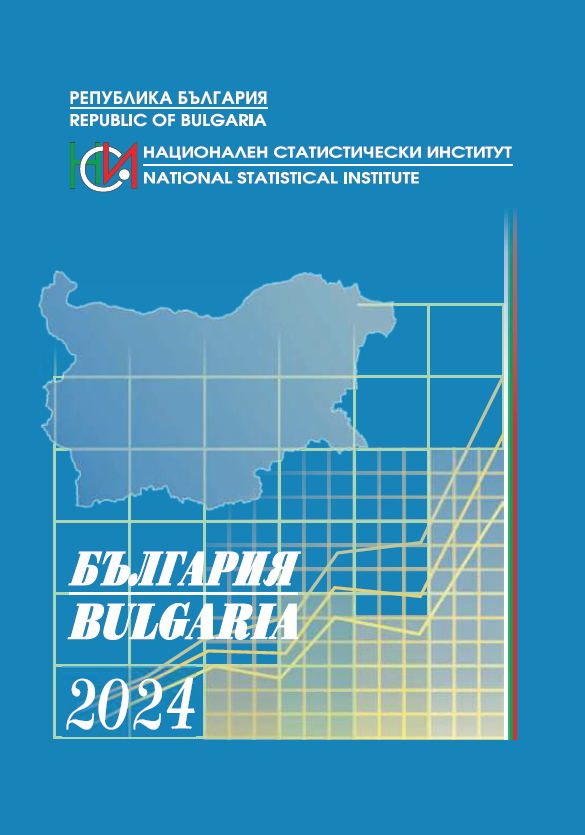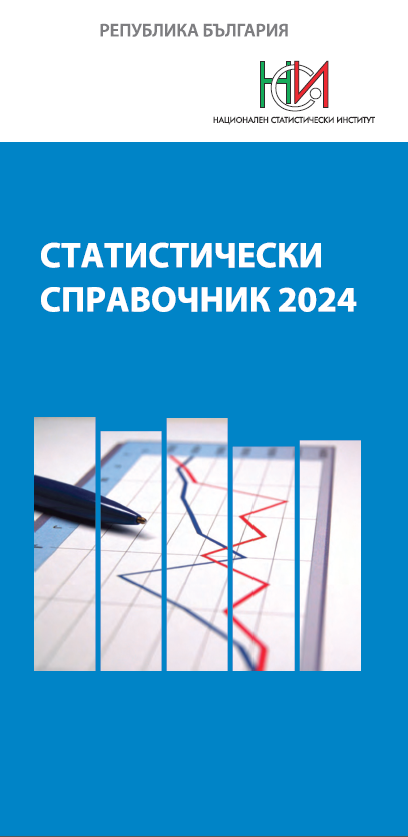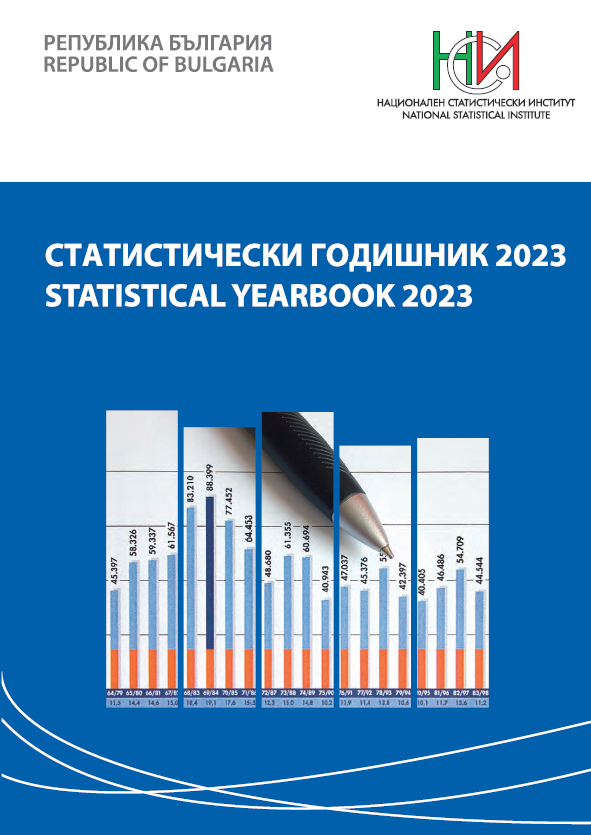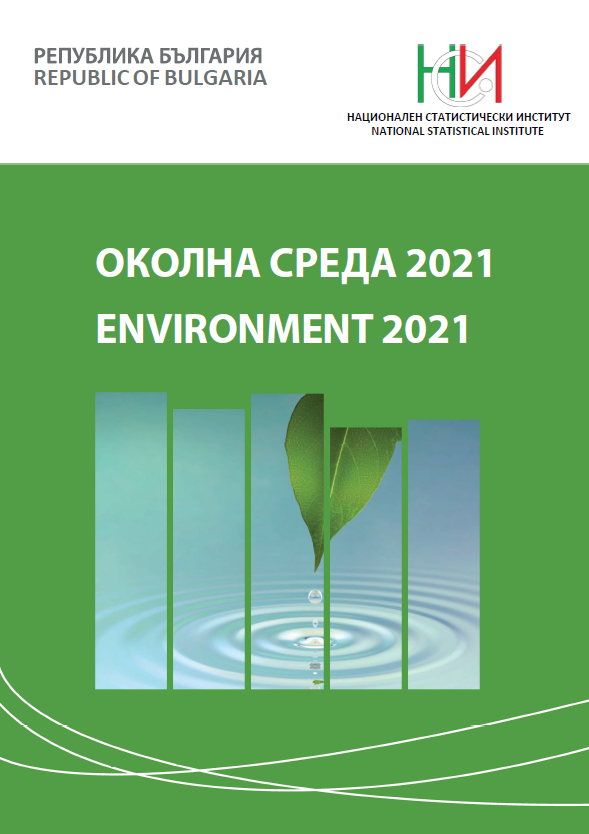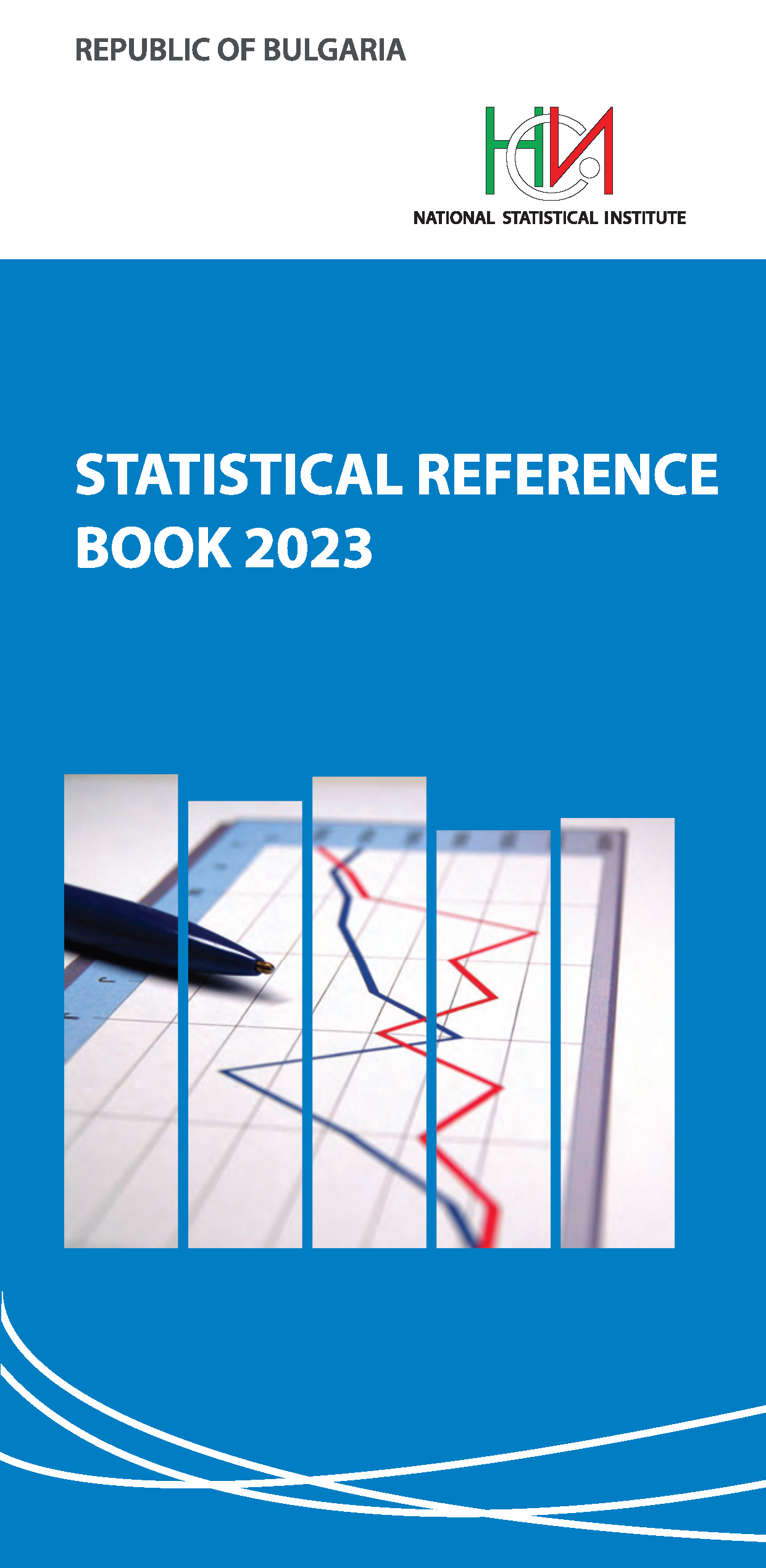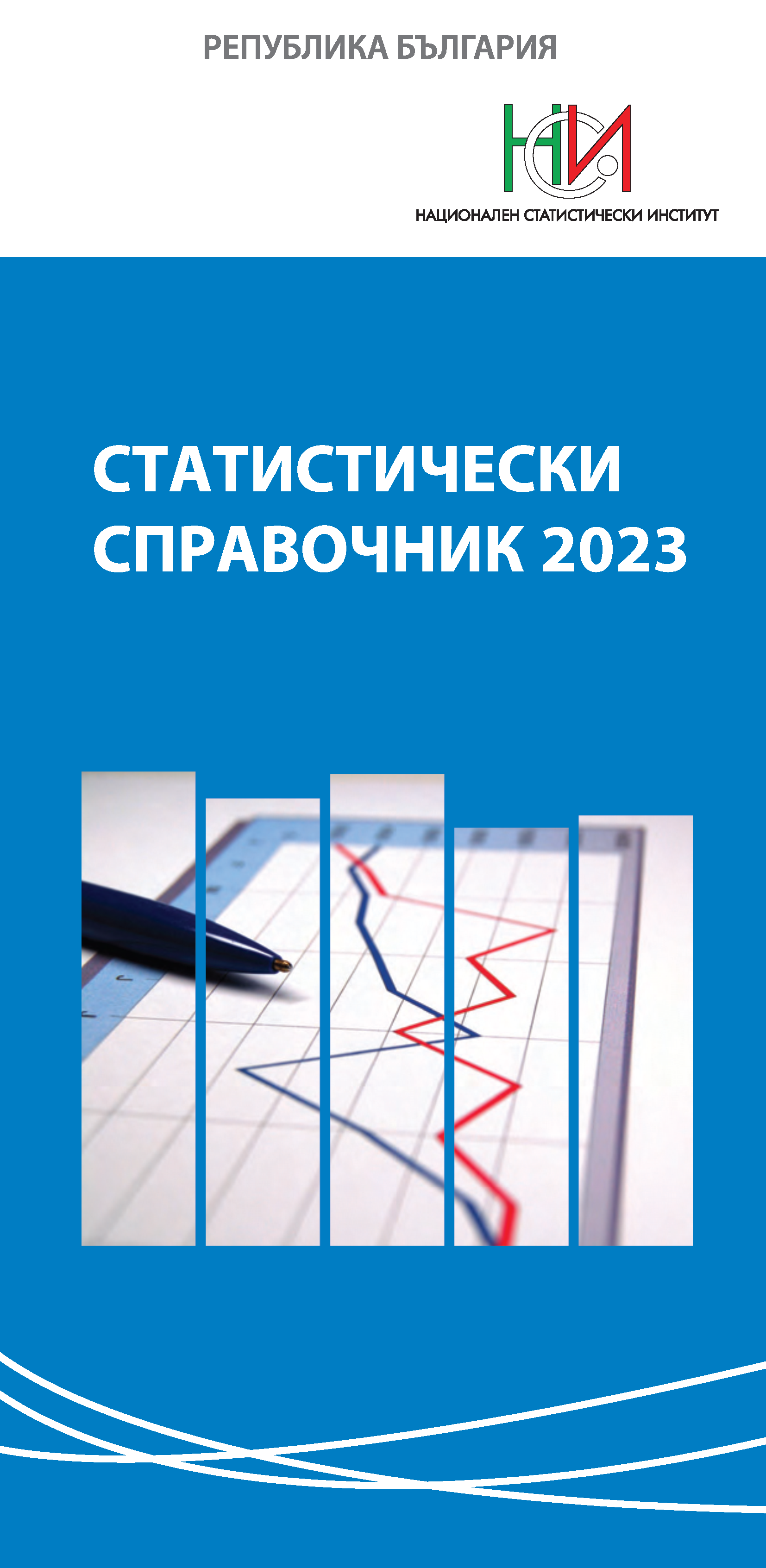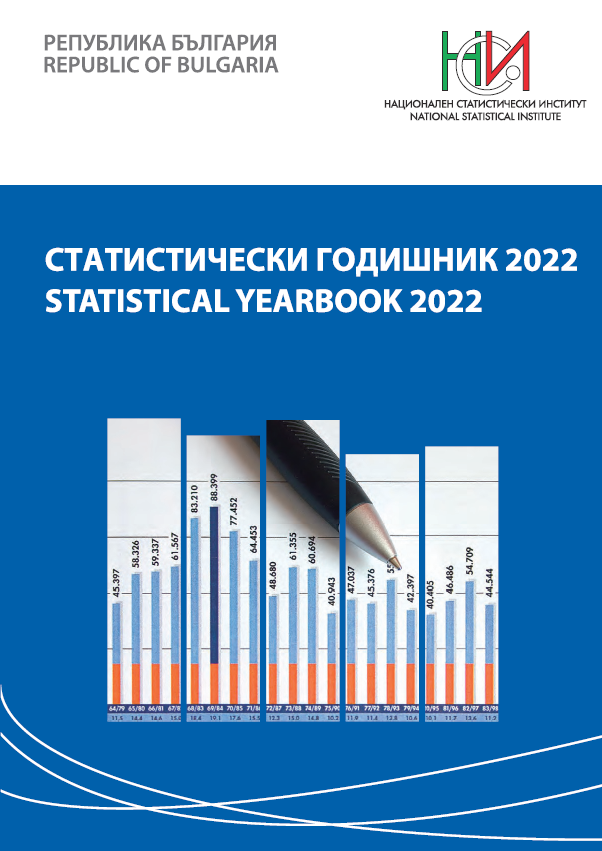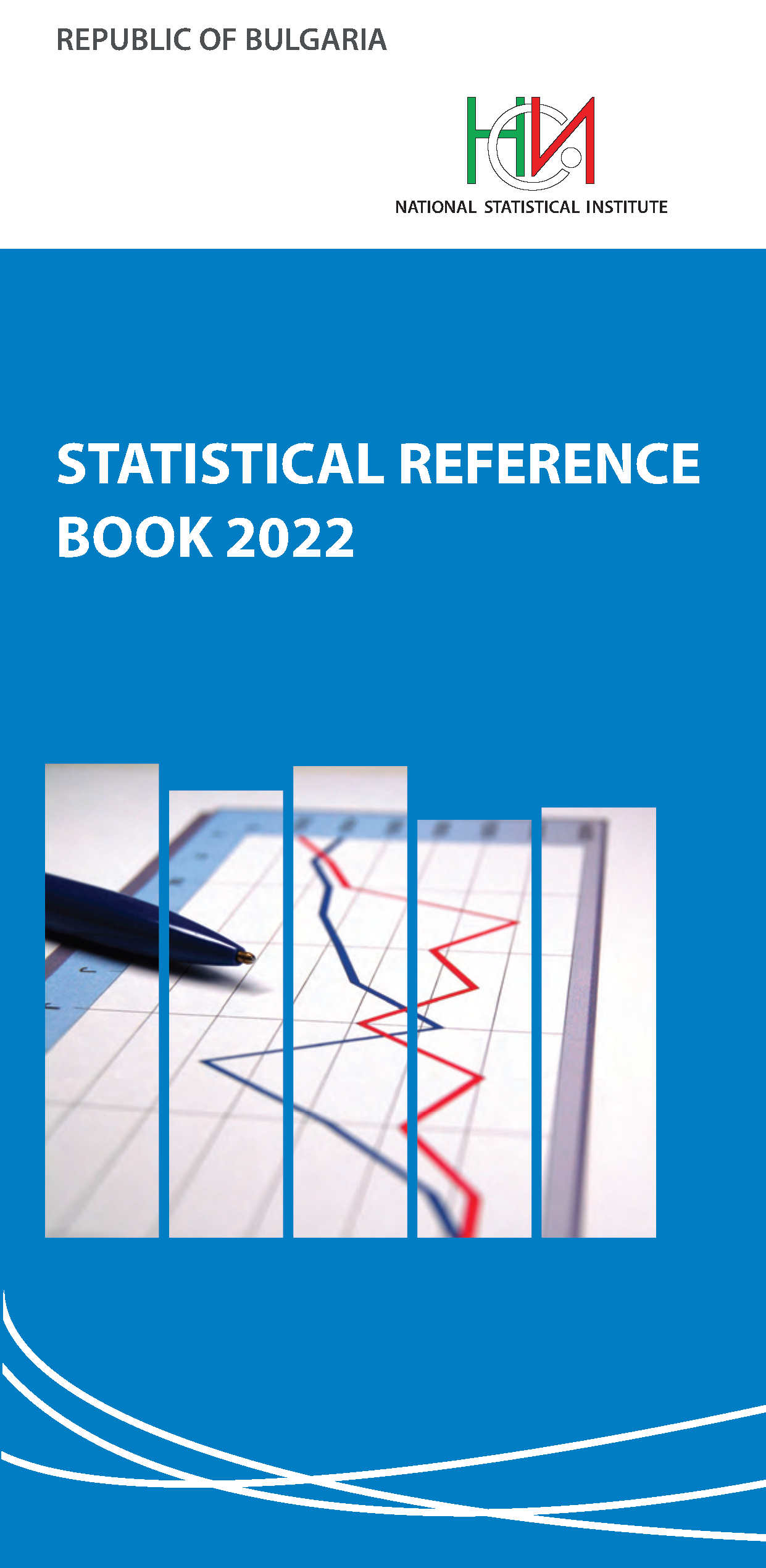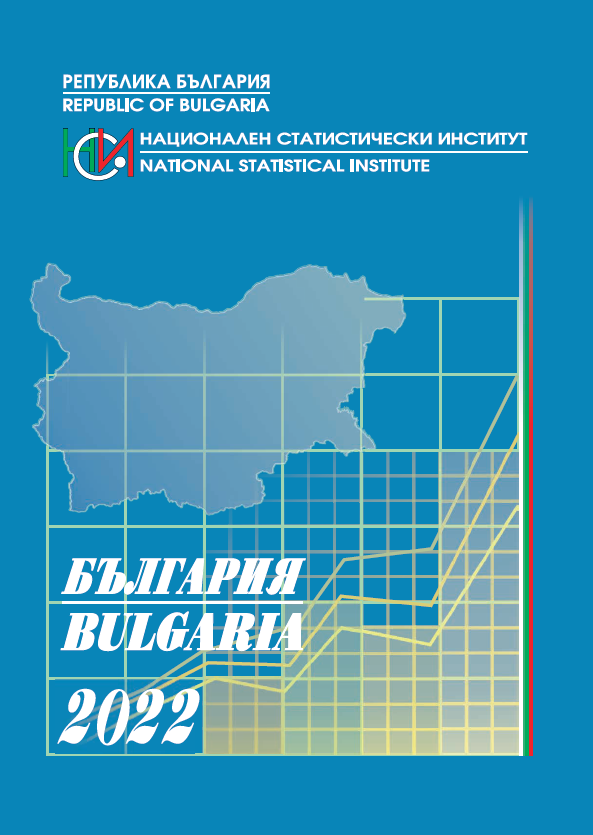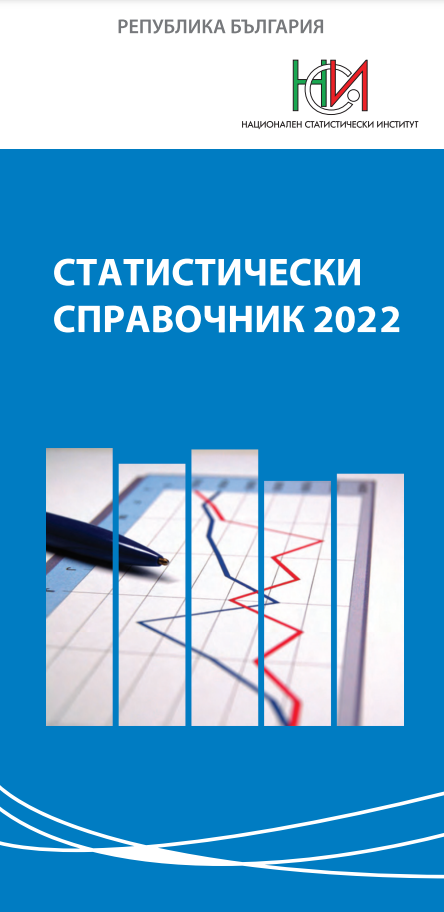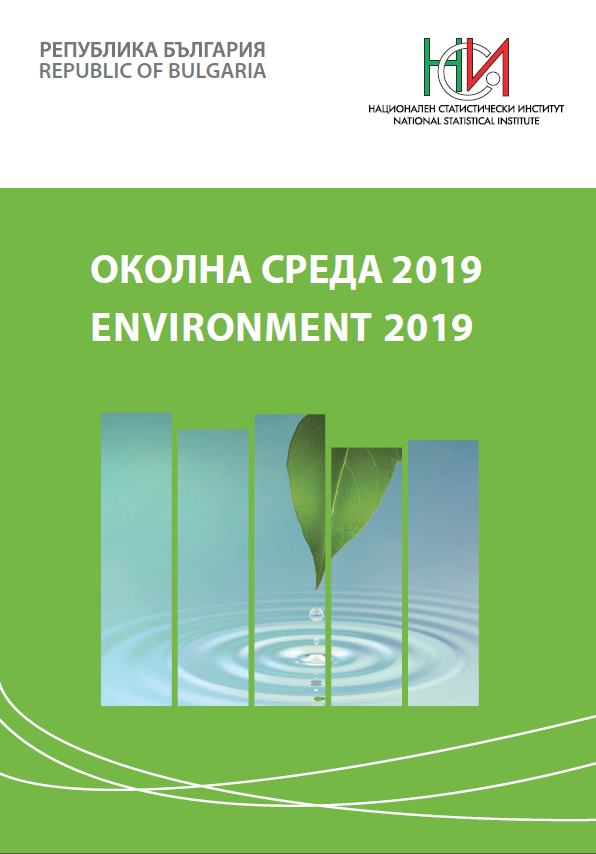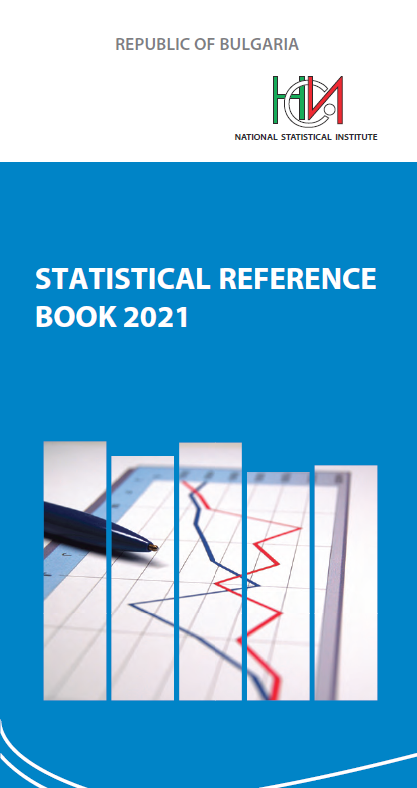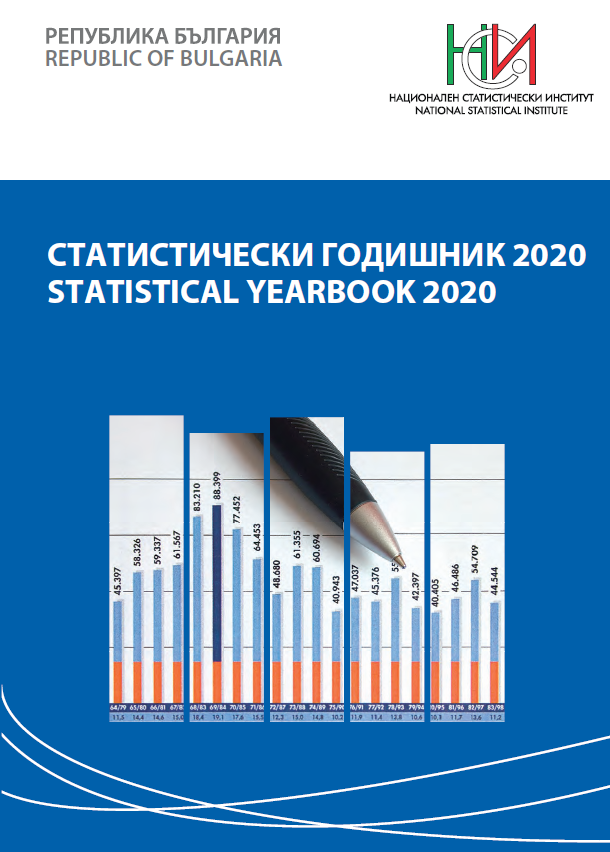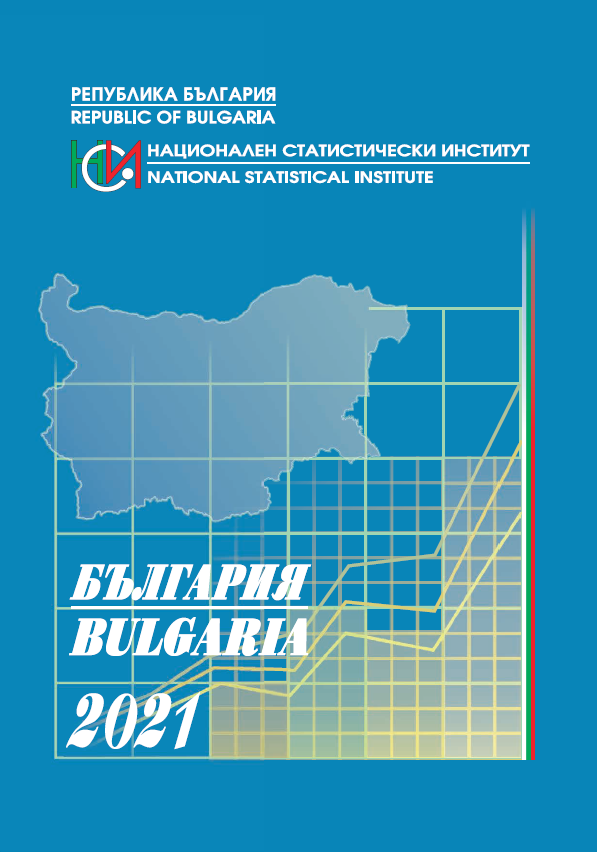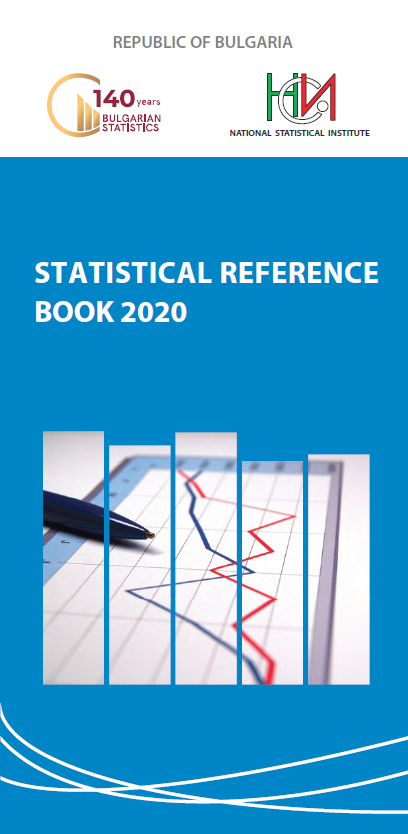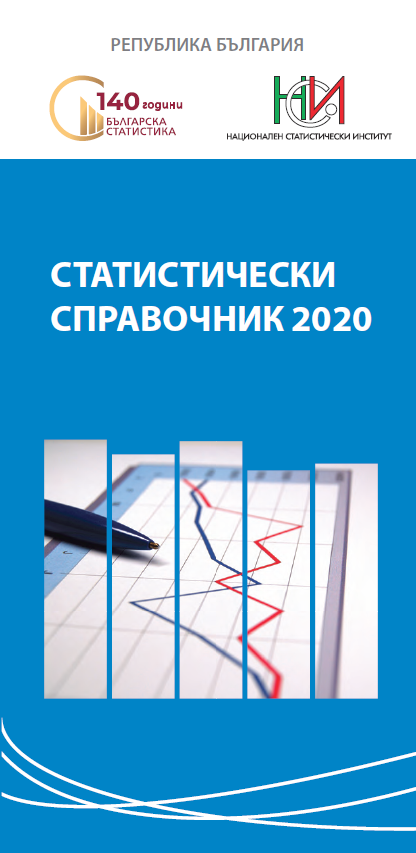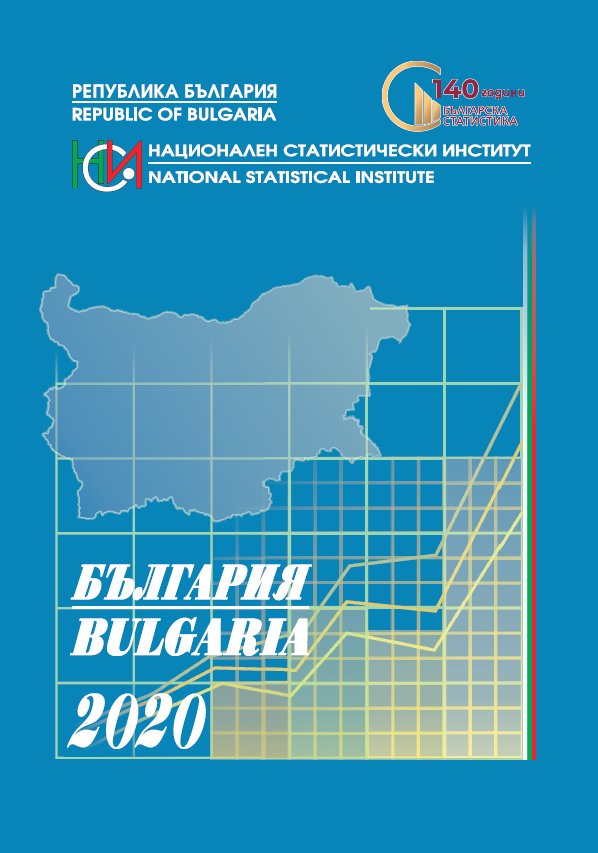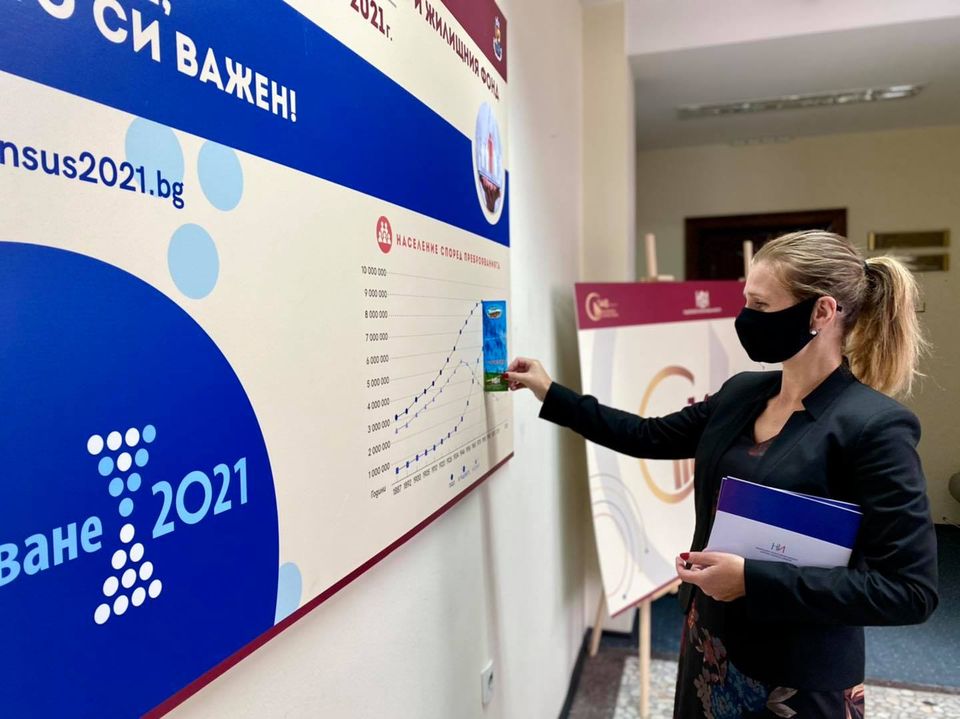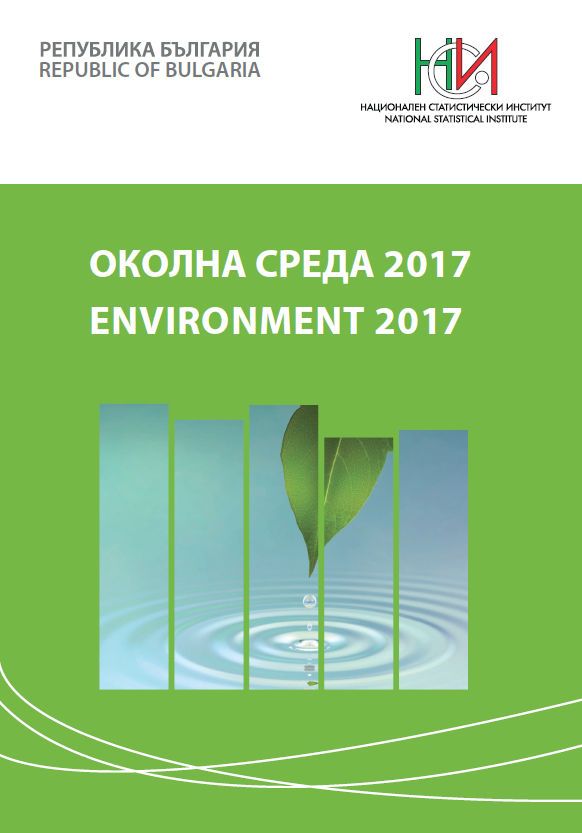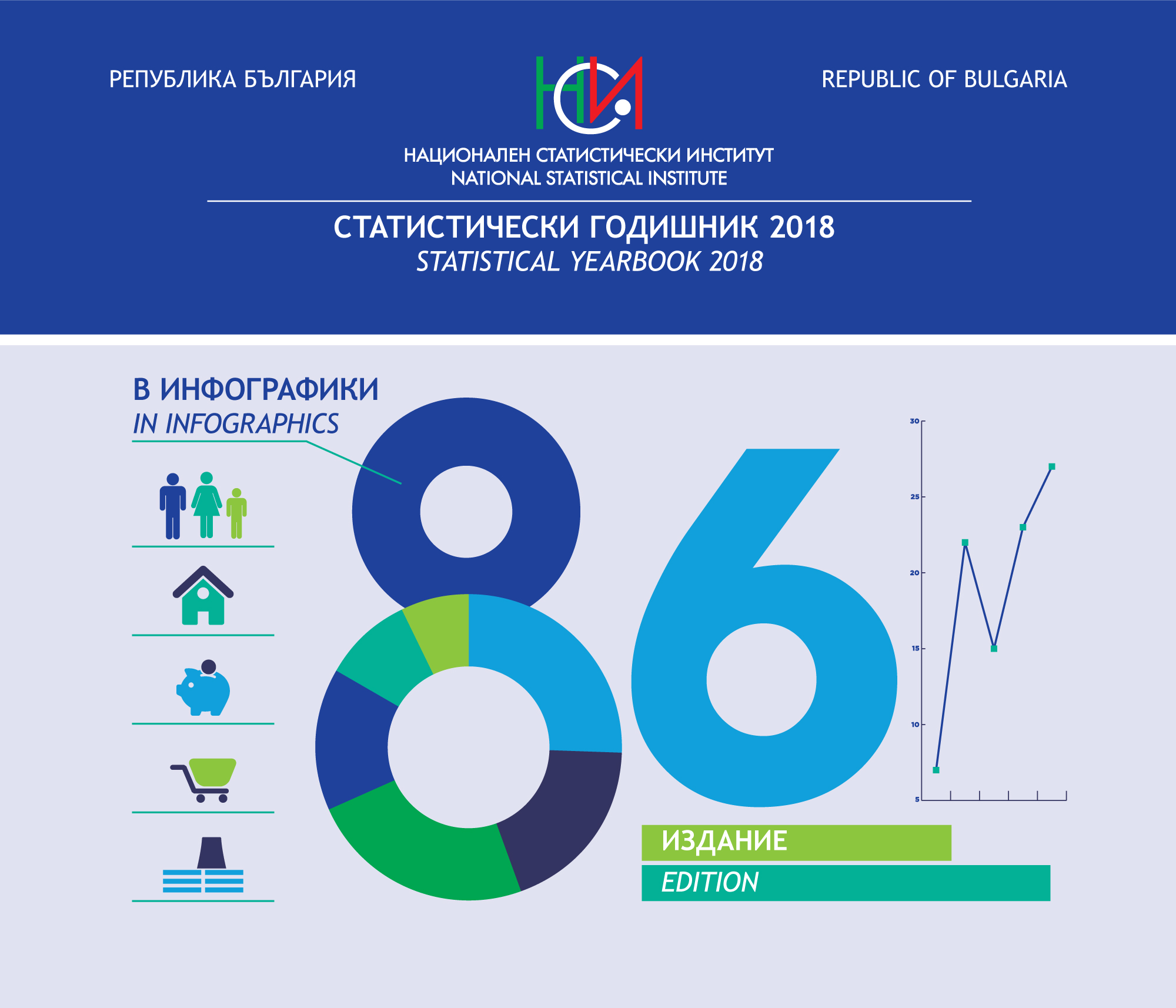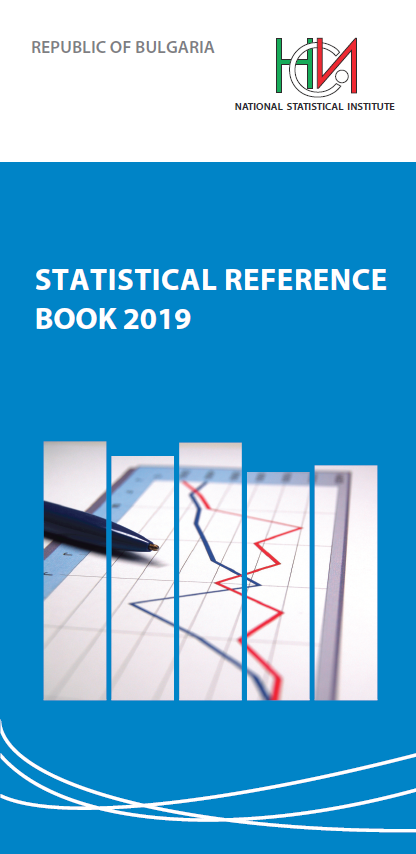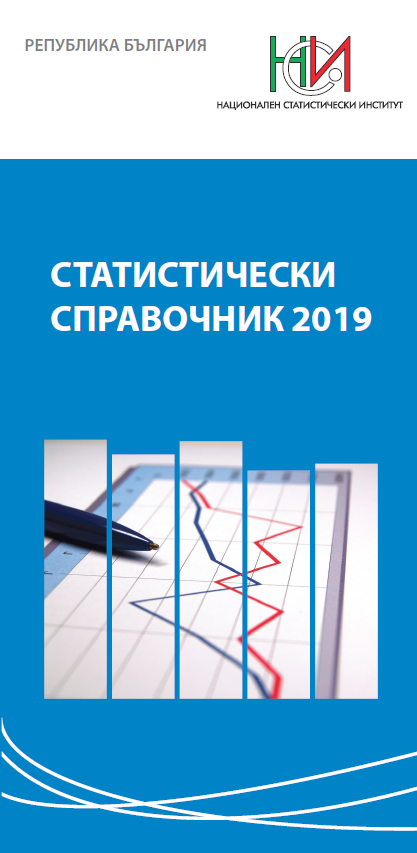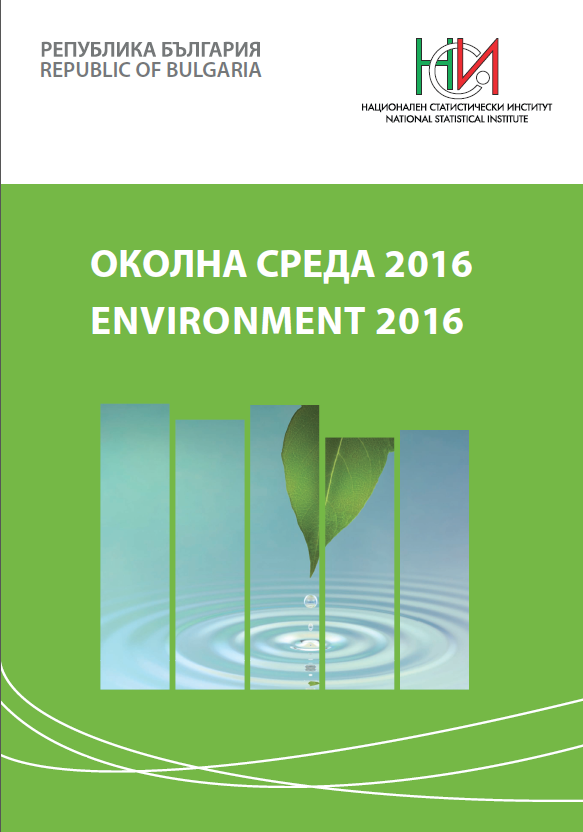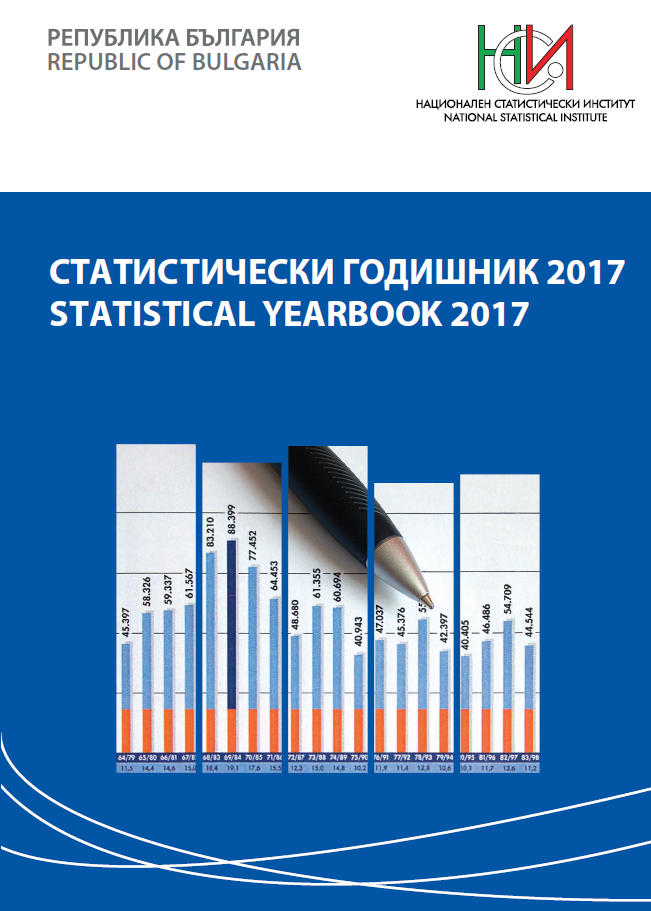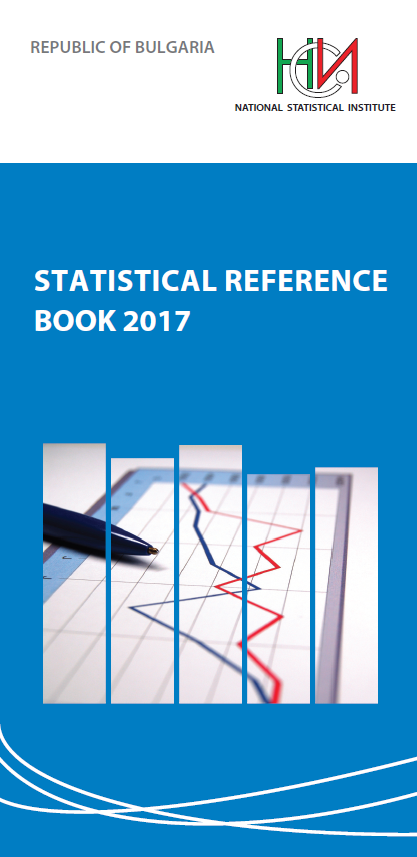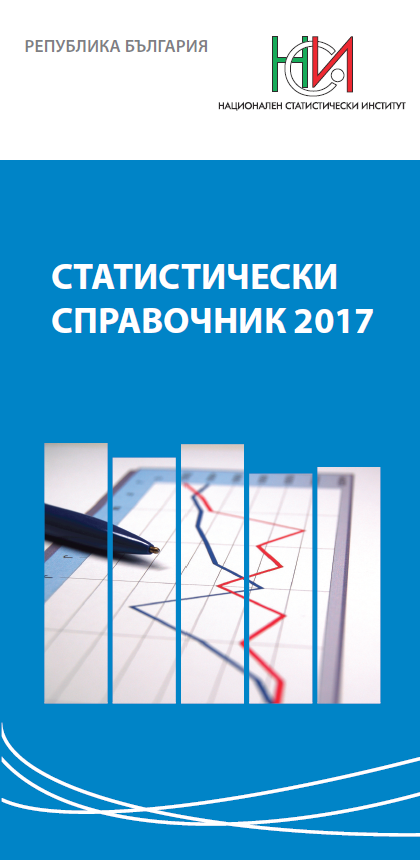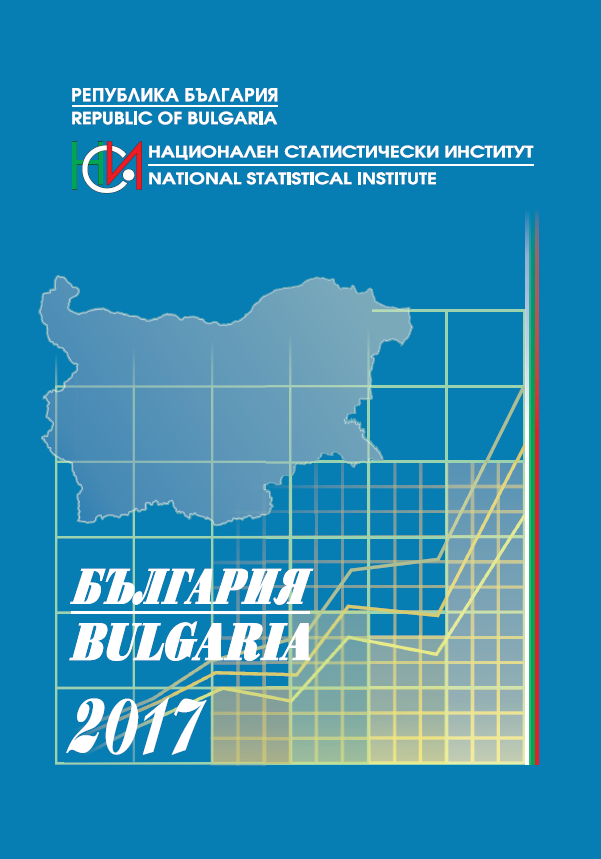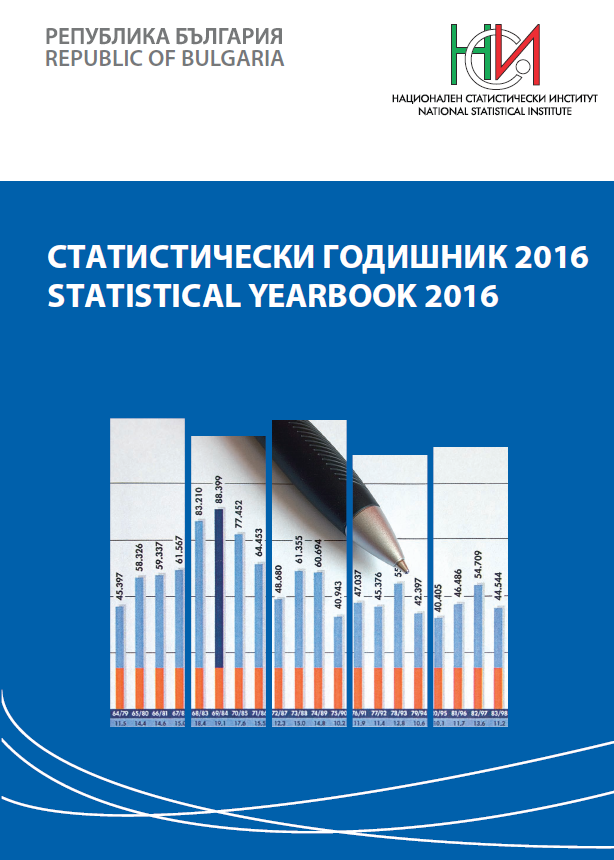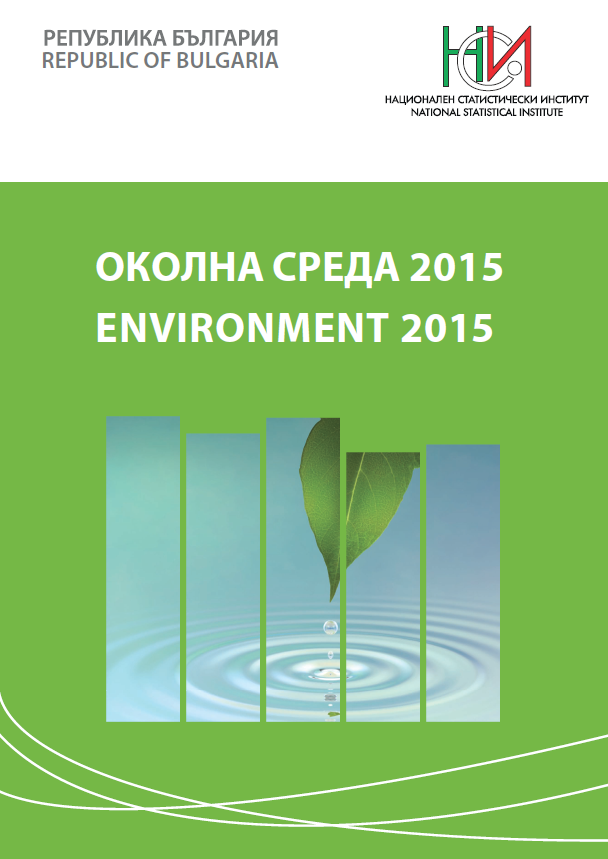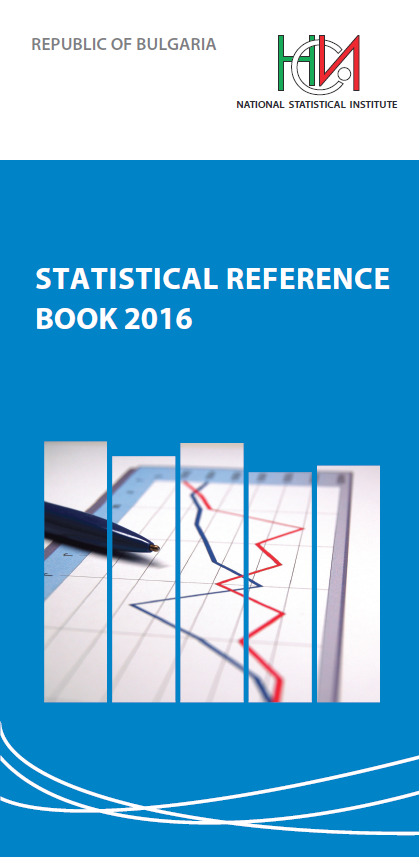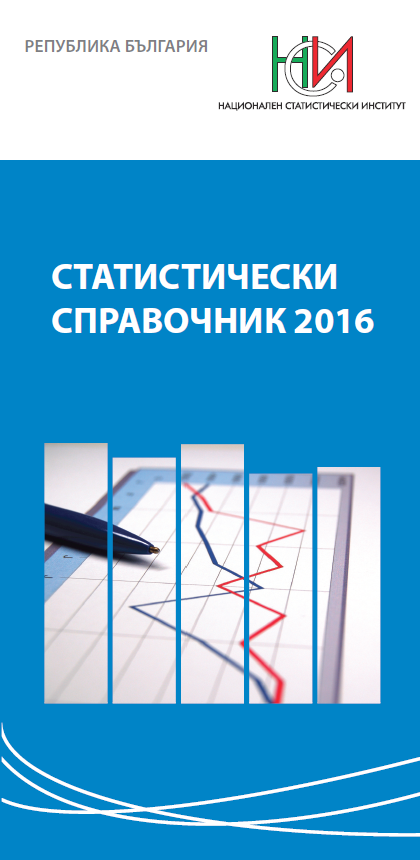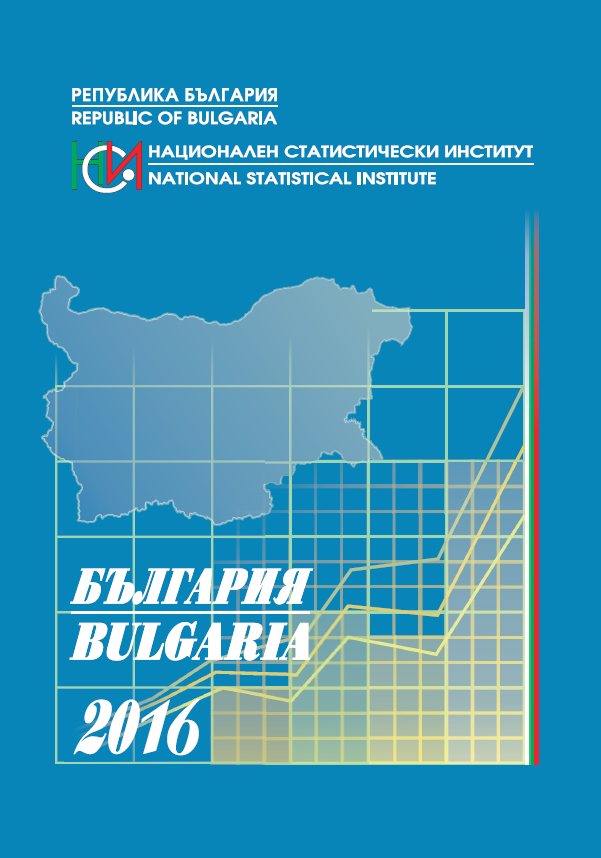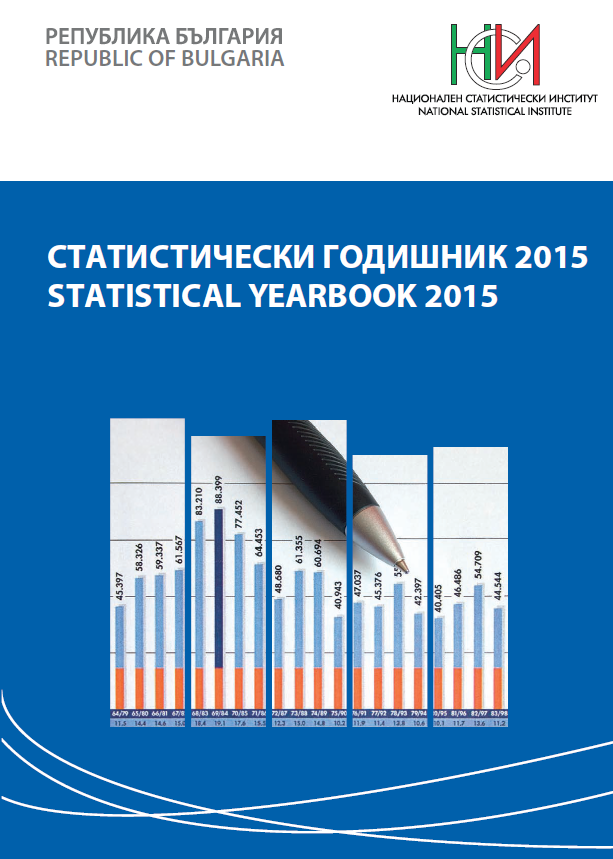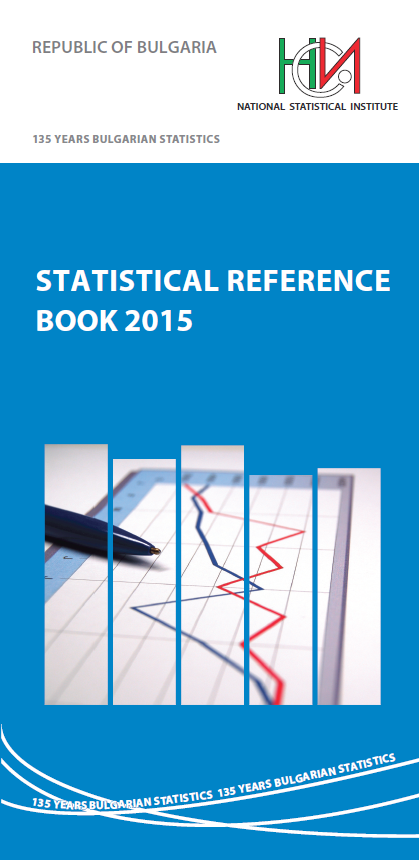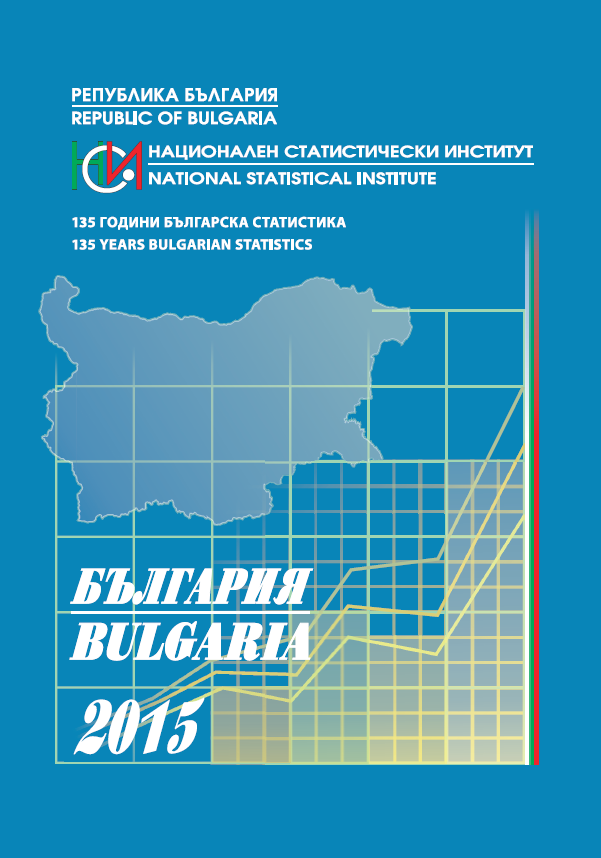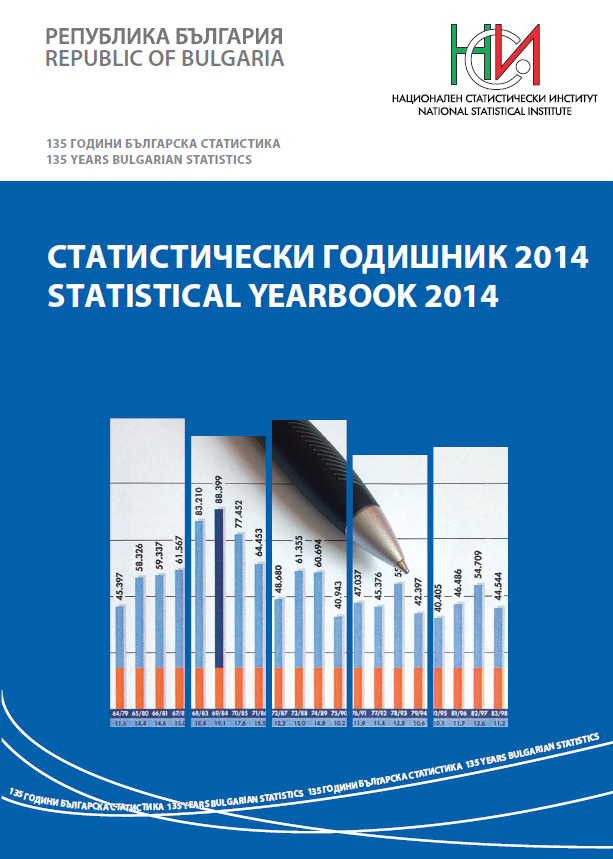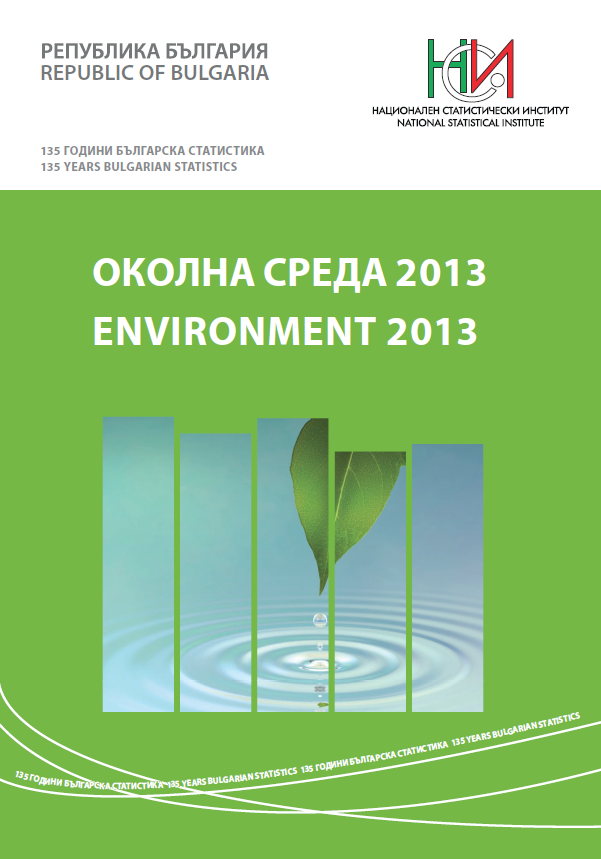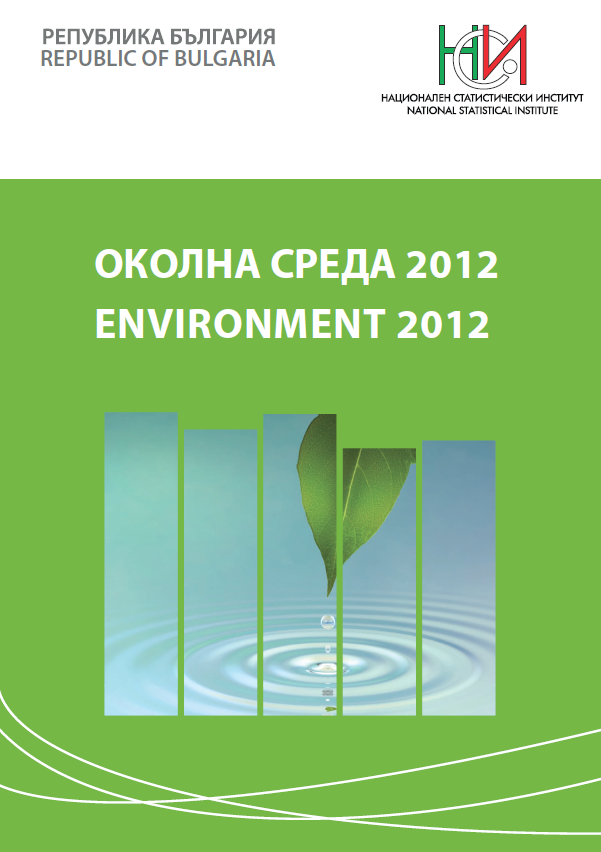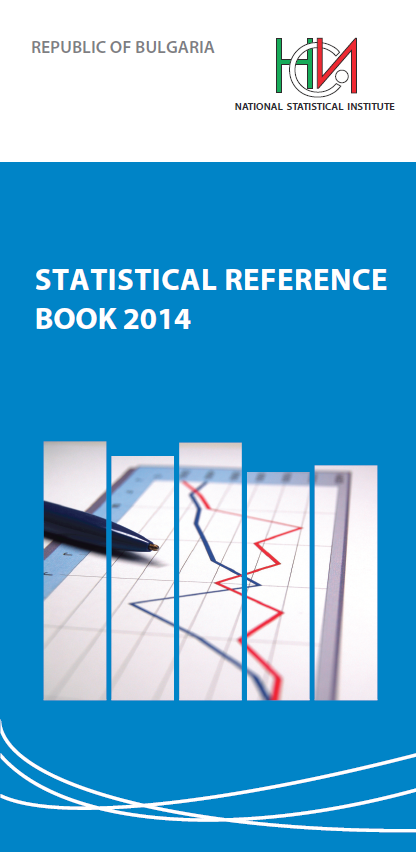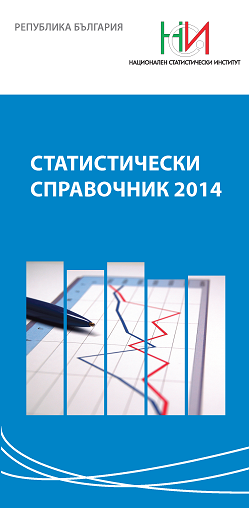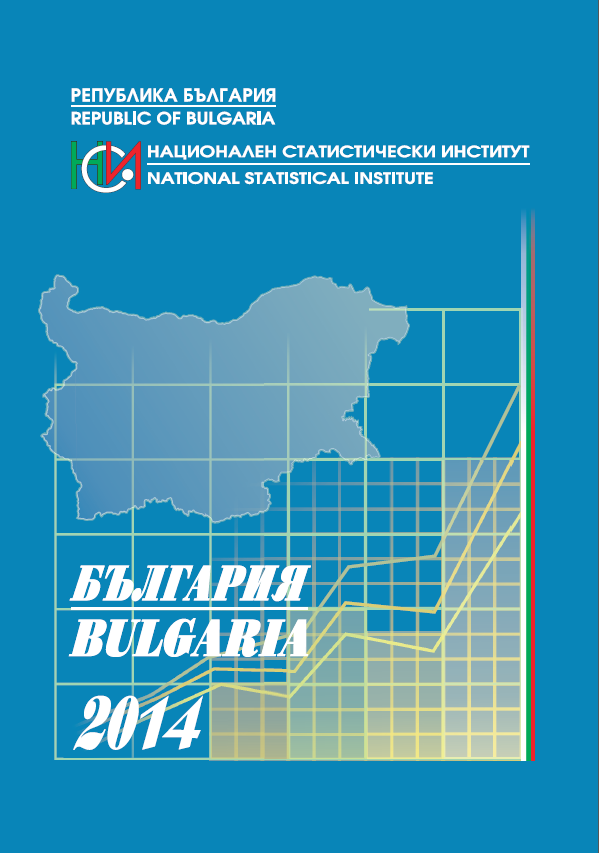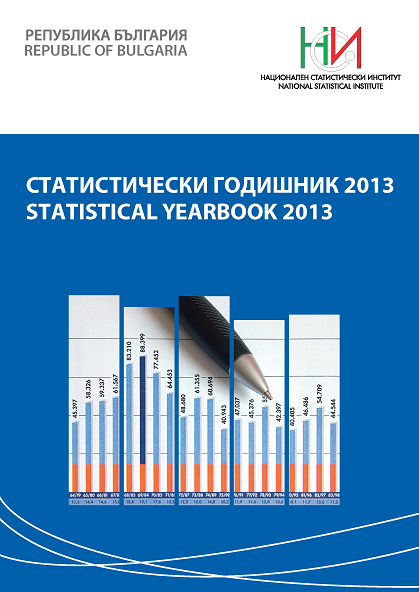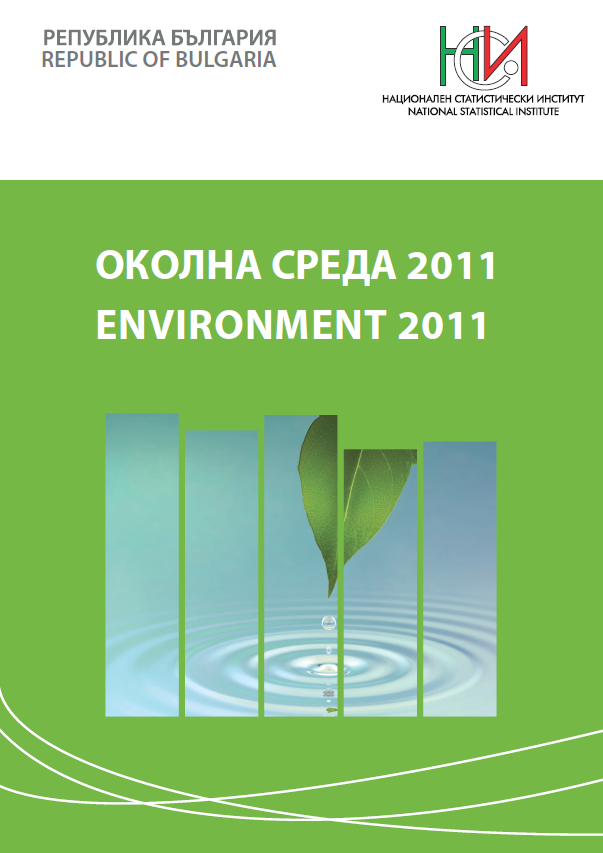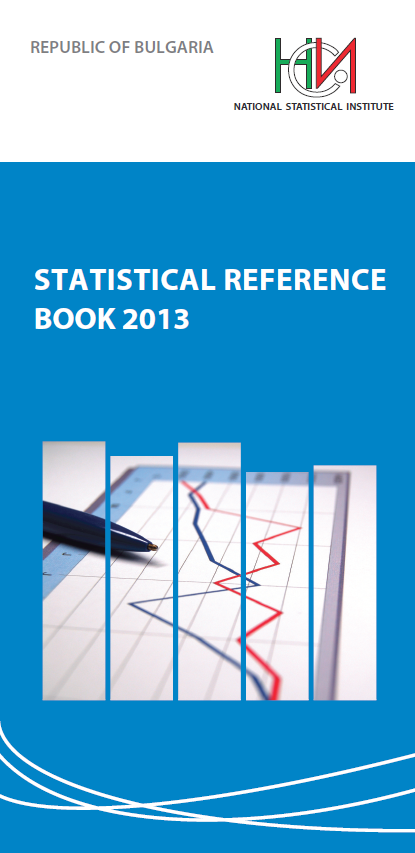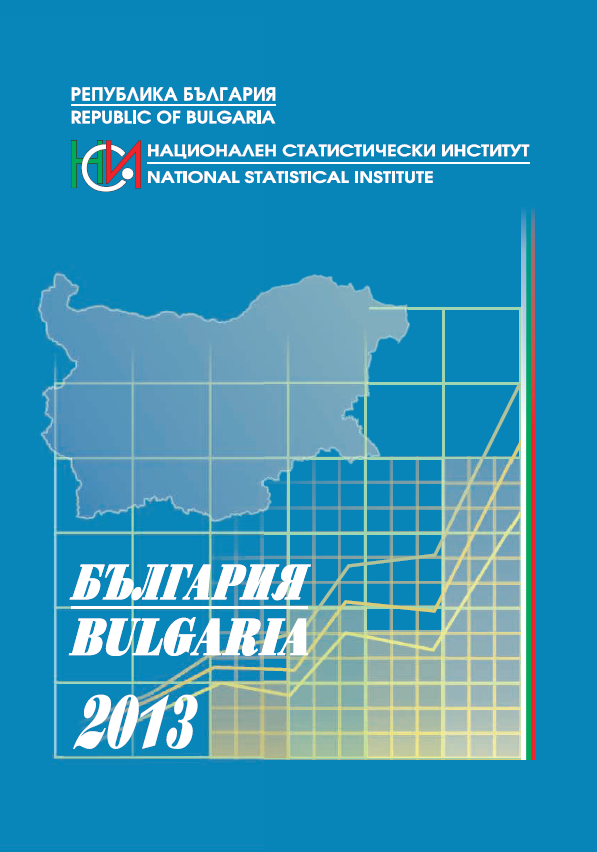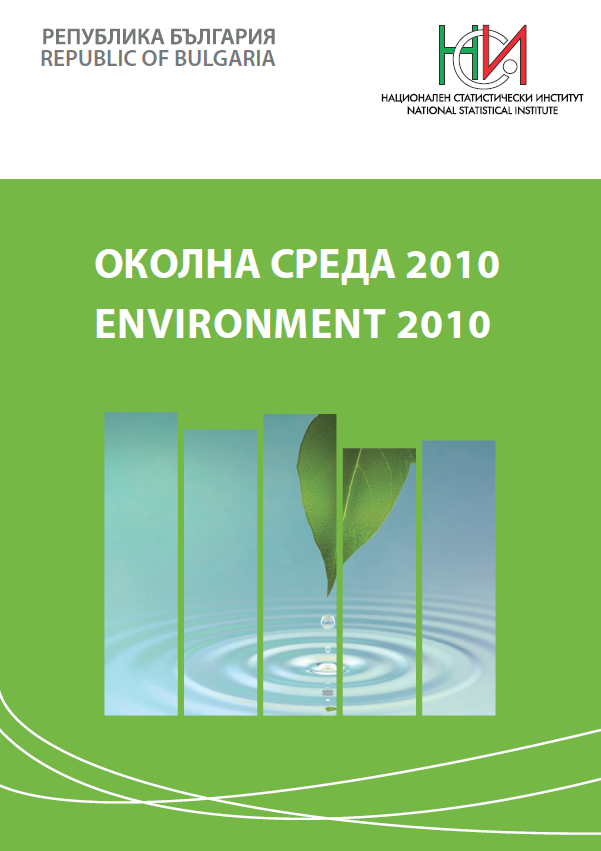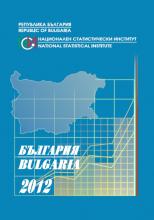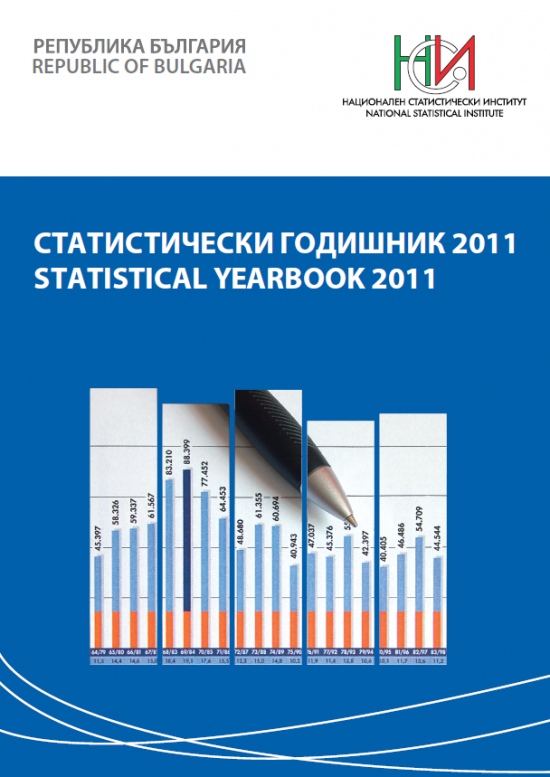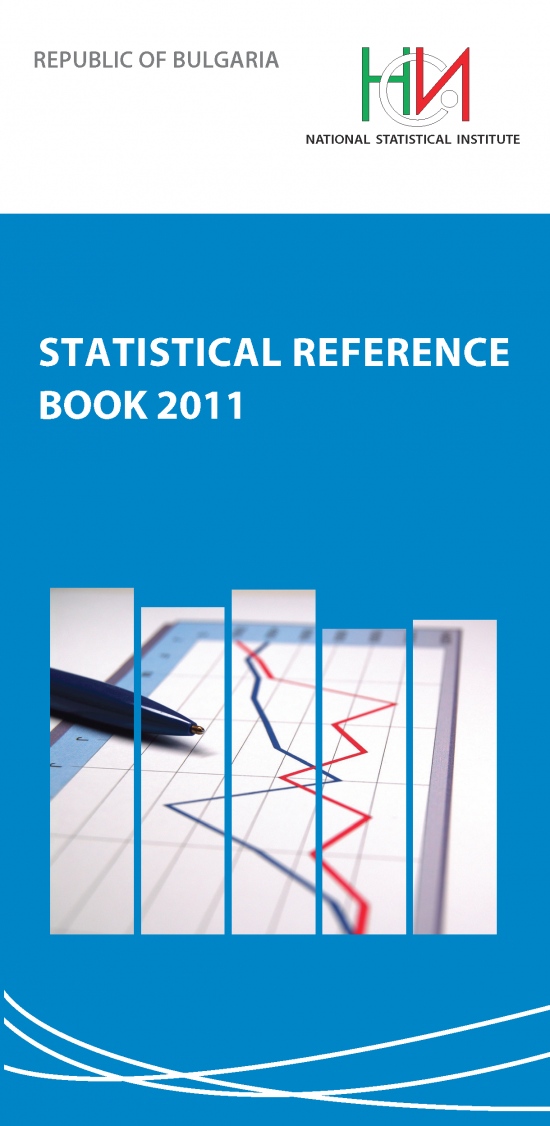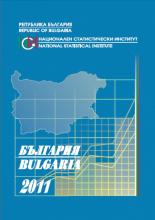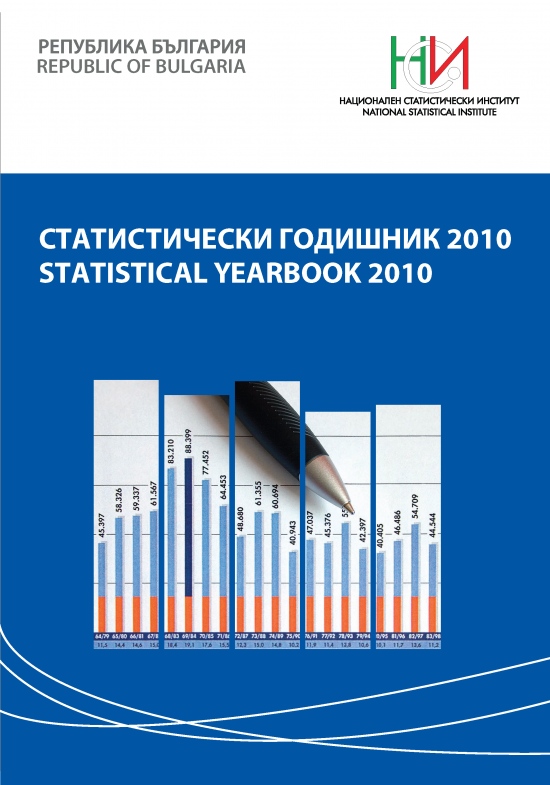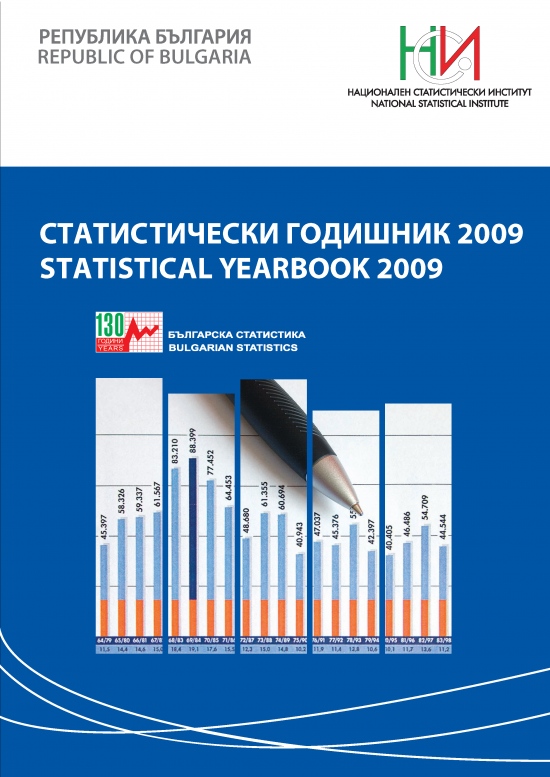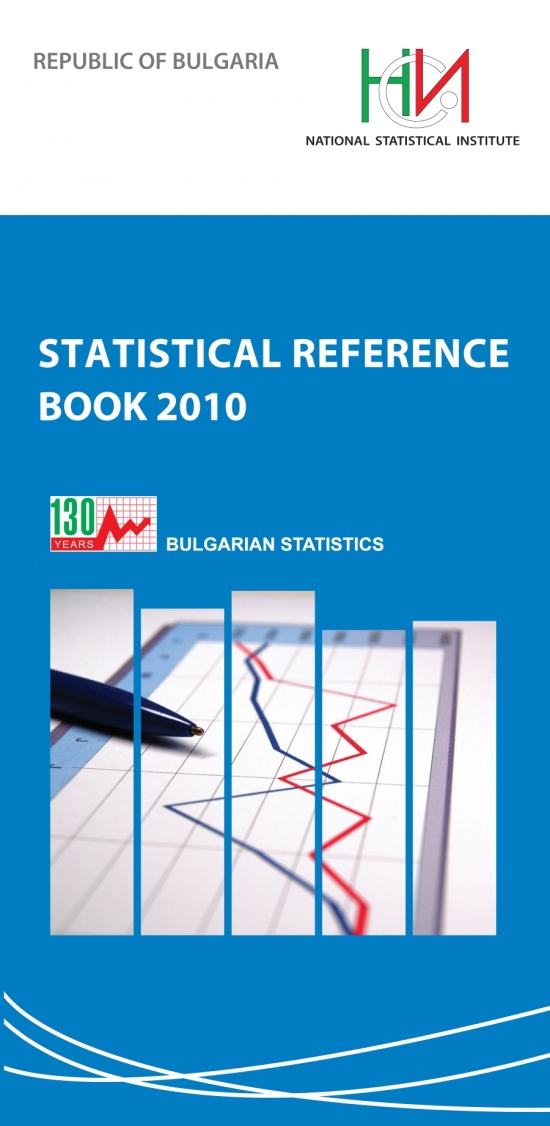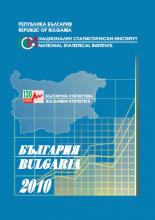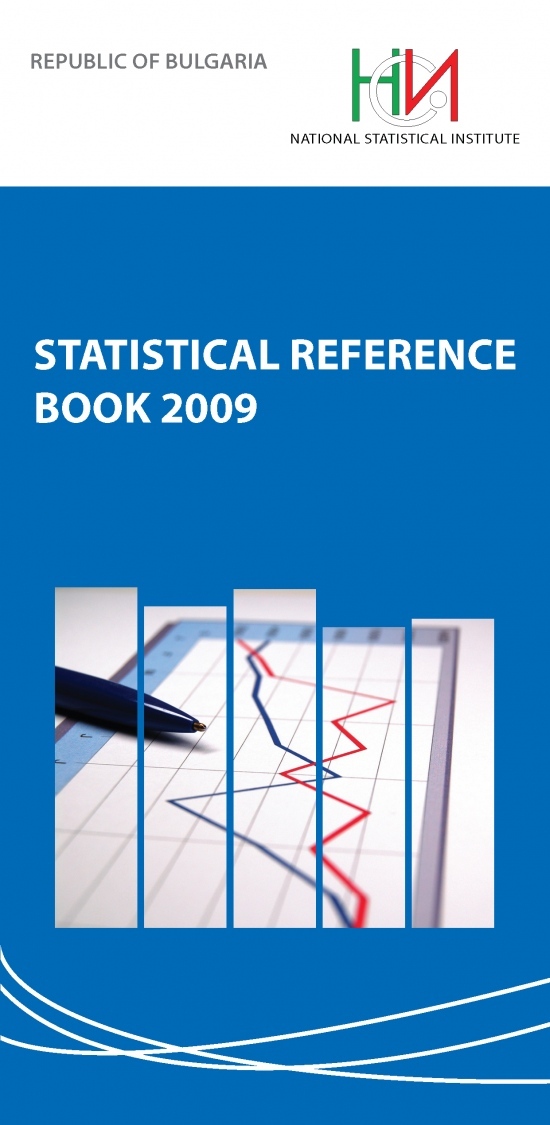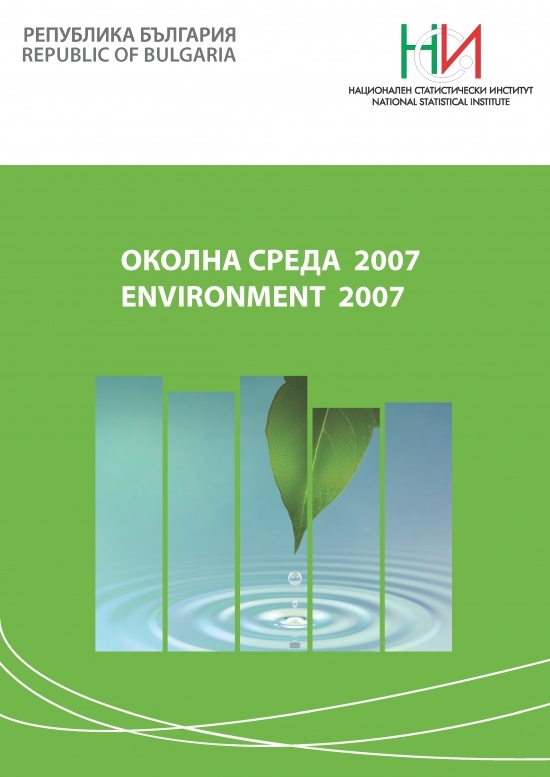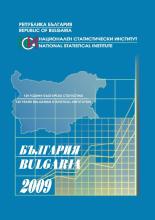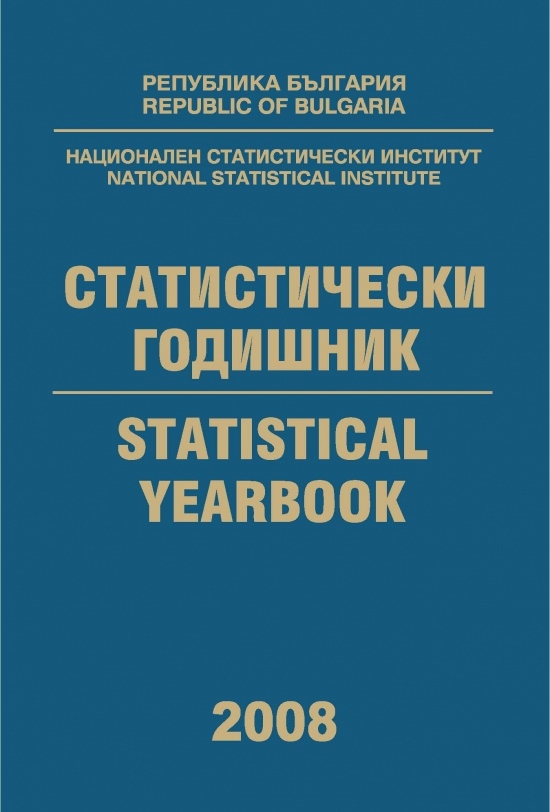Water used by economic activity - total for the country, by Statistical Region and River Basin District
| Contact | |
|---|---|
| Contact organisation | National Statistical Institute |
| Contact organisation unit | Environmental and Energy accounts Department |
| Contact name | Alexandra Ivanova Mariya Zlatkova |
| Contact person function | Chief expert Senior expert |
| Contact mail address | 2, P. Volov Str.; 1038 Sofia, |
| Contact email address | |
| Contact phone number | +359 2 9857 650 +359 2 9857 182 |
| Contact fax number | Not available. |
| Metadata update | |
| Metadata last certified | 17 February 2025 |
| Metadata last posted | 17 February 2025 |
| Metadata last update | 17 February 2025 |
| Statistical presentation | |
| Data description | The data provide information on the quantities of water abstraction, water used, wastewater generated and discharged, population with water services, urban water treatment plants, water supply and sewage network. The data are result of four statistical surveys: "Public water supply, sewage and treatment", "Water supply through irrigation systems", "Water use" and "Water used for hydro energy production (HPP/PWPP)". |
| Classification system | - Statistical Classification of Economic Activities (NACE Rev.2) - Unified Classifier of Administrative-Territorial and Territorial Units (UCATTU) - Classification of Territorial Units for Statistics in Bulgaria (NUTS) |
| Sector coverage | Statistical surveys cover: - "Public water supply, sewage and treatment" - all water suppliers - water supply operators and operators of urban drinking and wastewater treatment plants (water supply, municipalities). - "Water supply through irrigation systems" - enterprises and local units whose activity is the supply and distribution of water through irrigation/hydromelioration systems to end users. - "Water use" - the larger water users - enterprises for whose activities a total of over 36 thousand m3 of water enters or is extracted per year and a total of over 20 thousand cubic meters of water/year for the purposes of irrigation of agricultural areas, animal husbandry, industrial purposes (including cooling). Voluntarily submit data enterprises under this criterion. - "Water used for hydro energy production (HPP/PSHP)" - all the electricity producers - HPP/PSHP. |
| Statistical concepts and definitions | "Water abstraction" is the abstraction/removal of water from any water source, whether permanent or temporary. Abstracted water is divided into two categories - fresh and non-fresh water (marine and transitional). "Water used" is water that is actually used by end-users for a specific purpose within a within territory, such as for domestic use, irrigation or industrial processing. "Water losses" are the amount water lost during transport (through leakage and evaporation) between the source and the point of use. Respondents report losses using computational methods, as direct measurements are difficult to apply. The percentage is calculated as a proportion of the volume lost from the water entering the transport network. "Wastewater discharge" - The amount of water (in m3) or substance (in kg BOD/d or comparable) discharged to a water body from a point or non-point source. "Urban wastewater treatment plant" - the scope of survey are the treatment plants treating wastewater of settlements on behalf of the state administration (public services). The information contains the main characteristics of the urban wastewater treatment plants (UWTPs) operating in the country - treatment methods, design capacity (water volume and BOD5), input and output load (BOD5), connected settlements. The treatment methods correspond to the definitions in the national legislation. Definitions are used, according to applicable legislation - Data Collection Manual for the OECD/Eurostat Joint Questionnaire on Inland Waters and Eurostat Regional Water Questionnaire - Concepts, definitions, current practices, evaluations and recommendations, and Joint Questionnaire on Inland Waters (JQ-IW) and Eurostat’s Regional Water Questionnaire (RWQ) - Definitions, notes, relations and schemes. |
| Statistical unit | - "Public water supply, sewerage and treatment" - a water supplier enterprise and operator of urban drinking water and wastewater treatment plants. - "Water supply through irrigation systems" - an enterprise or local units engaged in the supply and distribution of water through irrigation/hydromelioration systems to the end users. - "Water use" - enterprise or a local unit, a water user, according to the scope criterion. - "Water used for hydro energy production (HPP/PSHP)" - an enterprise producing electricity in HPP/PSHP. |
| Statistical population | - "Public water supply, sewerage and treatment" - enterprises, whose economic activity (according to NACE Rev.2) is generally related to water use. For the purpose of statistical monitoring, a list of enterprises that carry out activities under NACE Rev.2 "36.00 Water collection, treatment and supply" – public water supply operators and operators of urban treatment plants for drinking and wastewater (water supply, municipalities) is prepared. - "Water supply through irrigation systems" - enterprises and local units, whose economic activity (according to NACE Rev.2 ) is generally related to the water supply and distribution through irrigation/hydromelioration systems to the end users. - "Water use" - enterprises and local units, whose economic activity (according to NACE Rev.2) is generally related to the use of water. - "Water used for hydro energy production (HPP/PSHP)" - statistical units, whose economic activity (according NACE Rev.2) is related to the use of water for 35.11- Production of electricity. |
| Reference area | Bulgaria (country); Statistical region - NUTS2; Statistical zone - NUTS1; District - NUTS3; River Basin Districts. |
| Time coverage | 1990 - 2023 |
| Base period | Not applicable. |
| Unit of measure | |
- Water abstraction by sources - millions cubic meter; - Water distribution by Public Water Supply - millions cubic meter; - Water used by economic activity - millions cubic meter; - Drinking water used by households from Public water supply - liters per person per day; - Generation and discharge of wastewater - millions cubic meter; - Operating urban wastewater treatment plants - count; - Water supply and sewage network - kilometer; - Population and water services - percent. | |
| Reference period | |
Calendar year. | |
| Institutional mandate | |
| Legal acts and other agreements | Regulatory Documents: - Regulation (EC) No 223/2009 on European statistics - Ordinance on the order and manner of organizing national inventories of emissions of harmful substances and greenhouse gases into the atmosphere (only in Bulgarian) - Voluntary provision of national and regional water data to Eurostat/OECD - Gentlemen's Agreement Аgreements: Agreements between the National Statistical Institute and the Ministry of Environment and Water for cooperation and exchange of information from 2003 and 2010. |
| Data sharing | Water statistics data are provided annually to the Executive Agency for the Environment, for preparation and reporting of the National Inventory of Emissions of Harmful Substances, in accordance with the Convention on Long-Range Transboundary Air Pollution (LRTAP) and the United Nations Framework Convention on Climate Change (UNFCCC). |
| Confidentiality | |
| Confidentiality - policy | Regulation (EC) No 223/2009 on European statistics provides the necessity to establish common principles and guidelines ensuring the confidentiality of data used for the production of European statistics and access to such confidential data, taking due account of technical developments and the requirements of users in a democratic society. The Statistics Act (Art. 25, para. 1) stipulates that individual data obtained and collected in statistical surveys are statistical secret and may be used only for statistical purposes. |
| Confidentiality - data treatment | According to Art. 25 of the Statistics Act, individual data may not disclose or provide. The provision of individual data is possible only according to Art. 26 of the Statistics Act. |
| Release policy | |
| Release calendar | The publication date of the statistical information are specified in the Calendar presenting the results of the statistical surveys of the NSI. |
| Release calendar access | The calendar is available on the NSI website here. |
| User access | Water statistics data are published on the NSI website in the "Environment" section according to the provisions of the Statistics Act and the principles of the European Statistical Code of Practice, respecting professional independence and aiming at objectivity and transparency, whereby all users are equal. |
| Frequency of dissemination | |
Annually. | |
| Accessibility and clarity | |
| News release | Regular press release on the NSI website. |
| Publications | - Statistical Reference Book - Statistical Yearbook - Electronic publication "Environment" - Brochure "Bulgaria" |
| On-line database | Water statistics data are available on the NSI website at: |
| Micro-data access | According to Rules for Provision of Anonymised Individual Data for Scientific and Research Purposes of the NSI, anonymized individual data may be provided for scientific and research purposes. |
| Other | Information service on request, according to the Rules for Dissemination of Statistical Products and Services of the NSI. |
| Documentation on methodology | - Data Collection Manual for the OECD/Eurostat Joint Questionnaire on Inland Waters; - Internal guidelines "Environmental Statistics and Accounts". |
| Quality documentation | - European Statistics Code of Practice - Integrated management system in the NSI - Generic Statistical Business Process Model in the NSI (only in Bulgarian) - Handbook on internal quality audits of statistical processes and products in the NSI - Internal guidelines "Environmental Statistics and Accounts" Quality report is published annually with the publication of statistical data. |
| Quality management | |
| Quality assurance | The data quality is ensured by applying the principles of the European Statistics Code of Practice and the NSS Common Framework for Quality Management, including by applying the internal methodology "Statistics and Environmental Accounts", developed by the NSI. Quality assurance activities ensure compliance with the requirements of the Statistics Act in terms of quality criteria: adequacy, accuracy, timeliness, punctuality, accessibility and clarity, comparability and logical coherence. Through them, the application of the principles of the Code of European Statistical Practice is ensured: stable methodology; appropriate statistical procedures; moderate respondent burden; cost-effectiveness; relevance; accuracy; timeliness and accuracy of presentation; comparability and coherence; accessibility and clarity. |
| Quality assessment | The quality assessment is carried out at each stage of the statistical process (phases/subprocesses), accordingly to the Common Framework for Quality Management in the NSS and the principles of the European Statistics Code of Practice. The assessment of the statistical data quality includes statistical processes and statistical information. The requirements of the current methodological documents are applied for quality assessment, including the instructions in the internal guidelines "Statistics and Environmental Accounts", developed by the NSI. To assess the quality of the data, their compliance with the data from the Business statistics information system is checked - Income and Expenditure Statement, Tax and Fees Report, PRODENERG Report. In order to ensure the data quality, work is also being done to continuously improve the online-based information system for collecting primary data, providing an opportunity for arithmetic and logical control of the input data, and additional analyses and checks are being carried out. |
| Relevance | |
| User needs | The data from the water statistics serve both for reporting to various international institutions (Eurostat, UN Sustainable Development Goals, FAO, etc.) in the relevant formats, according to regulations, directives, signed agreements/contracts, and for carrying out assessments and analyses by various institutions or organizations in the country. The main users of statistical information from the survey are state and municipal organizations, scientific institutes, associations, companies and citizens. |
| User satisfaction | The NSI conducts a regular statistical survey "User Satisfaction with the Provided Statistical Information Products and Services", which covers all statistical areas. The survey aims to assess users’ satisfaction with the statistical information provided by the NSI and to define recommendations for the future development of the statistical system in accordance with user needs. |
| Completeness | The data meet the requirements of current legislation in terms of scope and monitored indicators. |
| Accuracy and reliability | |
| Overall accuracy | Data accuracy is guaranteed through quality assurance activities in the statistical production process, as one of the criteria for the quality of statistical information, according to the Statistics Act. |
| Sampling error | Not applicable. |
| Non-sampling error | Not applicable. |
| Timeliness and punctuality | |
| Timeliness | The data are published 14 months after the reporting year. |
| Punctuality | The data are published according to the Calendar presenting the results of the statistical surveys of the NSI. |
| Coherence and comparability | |
| Comparability - geographical | The data are prepared at national and regional level. The data are comparable with other EU countries due to the application of common definitions and classifications. |
| Comparability - over time | The data are comparable over time. For the main indicators of water statistics, data are available since 1990. Regional and more detailed information is available since 2008. Data revisions in the dynamic series is carried out when the methodology changes. |
| Coherence - cross domain | The data are coordinated with data from: - Registers of issued permits for water abstraction from surface and groundwater – Basin Directorates; - Register of issued guarantees – Sustainable Energy Development Agency(SEDA); - Data from energy and business statistics. Classification is applied according to the Classification of Economic Activities and the Classification of Territorial Units for Statistical Purposes in Bulgaria(NUTS). |
| Coherence - internal | The data are of high internal consistency. Within the framework of the quality assessment procedure, the consistency of primary and statistical data by sources, economic activities, national and regional level of aggregated and detailed data is checked. |
| Cost and burden | |
The costs (budget) for statistical surveys are disclosed in the National Statistical Program, published on the NSI website. The priority in conducting statistical surveys is to reduce the burden on respondents. Actions are being taken to alleviate the burden on respondents, such as: collecting and verifying primary data through the online-based information system "Environmental Statistics", containing strict arithmetic and logical control; improving the instructions for filling out questionnaires; providing methodological and technical assistance; continuously exploring the possibilities for using information from administrative and other sources; conducting annual trainings for respondents and NSI experts, etc. The time required to complete the statistical forms is used as the main measure of the workload of the respondents. For this purpose, a section is included in each form regarding the time needed to fill in the form (including the time for data preparation), which the respondents must complete. Based on this information and considering the specifics of the survey, the respondents' workload can be determined as relatively high. The overall workload of the responsible experts is determined as high, especially in cases of data revisions from previous reporting periods. | |
| Data revision | |
| Data revision - policy | According to the principles of the European Statistics Code of Practice and the requirements of the internal rules/integrated management system, statistical processes are regularly monitored and revised, if necessary. Revisions are carried out according to standard, established and transparent procedures. Regular analyses aim to improve data sources, statistical processes and products. |
| Data revision - practice | The data is revised upon change in regulatory requirements, the methodology, or when necessary. |
| Statistical processing | |
| Source data | - Statistical survey: "Public water supply, sewage and treatment"; "Water supply through irrigation systems"; "Water use" and "Water used for hydro energy production (HPP/PWPP)" - Administrative data (MOEW, EEA, BD, NIMH, SEDA). Information from other statistical surveys and administrative sources is also used to determine the general population, verify data, and perform estimation |
| Frequency of data collection | Annually. |
| Data collection | According to the respondents' activities, data is collected on: - Water abstraction; - Water used by activities; - Water services by settlements; - Active Urban treatment plants and facilities; - Wastewater generated and discharged; - Water used for hydropower production; - Length of the water supply and sewage network; - Other. |
| Data validation | Data validation is part of the activities to ensure the quality of statistical information. Primary data are validated in terms of completeness, correct classification, units of measurement, comparability with previous years, comparability with data from other statistical areas and/or administrative sources, logical control, etc. According to the quality criteria set out in the Statistics Act, statistical data are validated in terms of their comparability, accuracy, reliability, etc. |
| Data compilation | Data processing is carried out by strictly applying the methodology of the survey and data verification methods. Data processing includes actions to produce statistical data based on primary data, brought into an appropriate form, using specialized software products. |
| Adjustment | Not applicable. |
| Comment | |
ESS Standard for Quality Reports Structure (ESQRS)
| Contact | |
|---|---|
| Contact organisation | National Statistical Institute |
| Contact organisation unit | Environmental and Energy accounts Department |
| Contact name | Alexandra Ivanova Mariya Zlatkova |
| Contact person function | Chief expert Senior expert |
| Contact mail address | 2, P. Volov Str.; 1038 Sofia, |
| Contact email address | |
| Contact phone number | +359 2 9857 650 +359 2 9857 182 |
| Contact fax number | Not available. |
| Statistical presentation | |
| Data description | The data provide information on the quantities of water abstraction, water used, wastewater generated and discharged, population with water services, urban water treatment plants, water supply and sewage network. The data are result of four statistical surveys: "Public water supply, sewage and treatment", "Water supply through irrigation systems", "Water use" and "Water used for hydro energy production (HPP/PWPP)". |
| Classification system | - Statistical Classification of Economic Activities (NACE Rev.2) - Unified Classifier of Administrative-Territorial and Territorial Units (UCATTU) - Classification of Territorial Units for Statistics in Bulgaria (NUTS) |
| Sector coverage | Statistical surveys cover: - "Public water supply, sewage and treatment" - all water suppliers - water supply operators and operators of urban drinking and wastewater treatment plants (water supply, municipalities). - "Water supply through irrigation systems" - enterprises and local units whose activity is the supply and distribution of water through irrigation/hydromelioration systems to end users. - "Water use" - the larger water users - enterprises for whose activities a total of over 36 thousand m3 of water enters or is extracted per year and a total of over 20 thousand cubic meters of water/year for the purposes of irrigation of agricultural areas, animal husbandry, industrial purposes (including cooling). Voluntarily submit data enterprises under this criterion. - "Water used for hydro energy production (HPP/PSHP)" - all the electricity producers - HPP/PSHP. |
| Statistical concepts and definitions | "Water abstraction" is the abstraction/removal of water from any water source, whether permanent or temporary. Abstracted water is divided into two categories - fresh and non-fresh water (marine and transitional). "Water used" is water that is actually used by end-users for a specific purpose within a within territory, such as for domestic use, irrigation or industrial processing. "Water losses" are the amount water lost during transport (through leakage and evaporation) between the source and the point of use. Respondents report losses using computational methods, as direct measurements are difficult to apply. The percentage is calculated as a proportion of the volume lost from the water entering the transport network. "Wastewater discharge" - The amount of water (in m3) or substance (in kg BOD/d or comparable) discharged to a water body from a point or non-point source. "Urban wastewater treatment plant" - the scope of survey are the treatment plants treating wastewater of settlements on behalf of the state administration (public services). The information contains the main characteristics of the urban wastewater treatment plants (UWTPs) operating in the country - treatment methods, design capacity (water volume and BOD5), input and output load (BOD5), connected settlements. The treatment methods correspond to the definitions in the national legislation. Definitions are used, according to applicable legislation - Data Collection Manual for the OECD/Eurostat Joint Questionnaire on Inland Waters and Eurostat Regional Water Questionnaire - Concepts, definitions, current practices, evaluations and recommendations, and Joint Questionnaire on Inland Waters (JQ-IW) and Eurostat’s Regional Water Questionnaire (RWQ) - Definitions, notes, relations and schemes. |
| Statistical unit | - "Public water supply, sewerage and treatment" - a water supplier enterprise and operator of urban drinking water and wastewater treatment plants. - "Water supply through irrigation systems" - an enterprise or local units engaged in the supply and distribution of water through irrigation/hydromelioration systems to the end users. - "Water use" - enterprise or a local unit, a water user, according to the scope criterion. - "Water used for hydro energy production (HPP/PSHP)" - an enterprise producing electricity in HPP/PSHP. |
| Statistical population | - "Public water supply, sewerage and treatment" - enterprises, whose economic activity (according to NACE Rev.2) is generally related to water use. For the purpose of statistical monitoring, a list of enterprises that carry out activities under NACE Rev.2 "36.00 Water collection, treatment and supply" – public water supply operators and operators of urban treatment plants for drinking and wastewater (water supply, municipalities) is prepared. - "Water supply through irrigation systems" - enterprises and local units, whose economic activity (according to NACE Rev.2 ) is generally related to the water supply and distribution through irrigation/hydromelioration systems to the end users. - "Water use" - enterprises and local units, whose economic activity (according to NACE Rev.2) is generally related to the use of water. - "Water used for hydro energy production (HPP/PSHP)" - statistical units, whose economic activity (according NACE Rev.2) is related to the use of water for 35.11- Production of electricity. |
| Reference area | Bulgaria (country); Statistical region - NUTS2; Statistical zone - NUTS1; District - NUTS3; River Basin Districts. |
| Time coverage | 1990 - 2023 |
| Base period | Not applicable. |
| Statistical processing | |
| Source data | - Statistical survey: "Public water supply, sewage and treatment"; "Water supply through irrigation systems"; "Water use" and "Water used for hydro energy production (HPP/PWPP)" - Administrative data (MOEW, EEA, BD, NIMH, SEDA). Information from other statistical surveys and administrative sources is also used to determine the general population, verify data, and perform estimation |
| Frequency of data collection | Annually. |
| Data collection | According to the respondents' activities, data is collected on: - Water abstraction; - Water used by activities; - Water services by settlements; - Active Urban treatment plants and facilities; - Wastewater generated and discharged; - Water used for hydropower production; - Length of the water supply and sewage network; - Other. |
| Data validation | Data validation is part of the activities to ensure the quality of statistical information. Primary data are validated in terms of completeness, correct classification, units of measurement, comparability with previous years, comparability with data from other statistical areas and/or administrative sources, logical control, etc. According to the quality criteria set out in the Statistics Act, statistical data are validated in terms of their comparability, accuracy, reliability, etc. |
| Data compilation | Data processing is carried out by strictly applying the methodology of the survey and data verification methods. Data processing includes actions to produce statistical data based on primary data, brought into an appropriate form, using specialized software products. |
| Adjustment | Not applicable. |
| Quality management | |
| Quality assurance | The data quality is ensured by applying the principles of the European Statistics Code of Practice and the NSS Common Framework for Quality Management, including by applying the internal methodology "Statistics and Environmental Accounts", developed by the NSI. Quality assurance activities ensure compliance with the requirements of the Statistics Act in terms of quality criteria: adequacy, accuracy, timeliness, punctuality, accessibility and clarity, comparability and logical coherence. Through them, the application of the principles of the Code of European Statistical Practice is ensured: stable methodology; appropriate statistical procedures; moderate respondent burden; cost-effectiveness; relevance; accuracy; timeliness and accuracy of presentation; comparability and coherence; accessibility and clarity. |
| Quality assessment | The quality assessment is carried out at each stage of the statistical process (phases/subprocesses), accordingly to the Common Framework for Quality Management in the NSS and the principles of the European Statistics Code of Practice. The assessment of the statistical data quality includes statistical processes and statistical information. The requirements of the current methodological documents are applied for quality assessment, including the instructions in the internal guidelines "Statistics and Environmental Accounts", developed by the NSI. To assess the quality of the data, their compliance with the data from the Business statistics information system is checked - Income and Expenditure Statement, Tax and Fees Report, PRODENERG Report. In order to ensure the data quality, work is also being done to continuously improve the online-based information system for collecting primary data, providing an opportunity for arithmetic and logical control of the input data, and additional analyses and checks are being carried out. |
| Relevance | |
| User needs | The data from the water statistics serve both for reporting to various international institutions (Eurostat, UN Sustainable Development Goals, FAO, etc.) in the relevant formats, according to regulations, directives, signed agreements/contracts, and for carrying out assessments and analyses by various institutions or organizations in the country. The main users of statistical information from the survey are state and municipal organizations, scientific institutes, associations, companies and citizens. |
| User satisfaction | The NSI conducts a regular statistical survey "User Satisfaction with the Provided Statistical Information Products and Services", which covers all statistical areas. The survey aims to assess users’ satisfaction with the statistical information provided by the NSI and to define recommendations for the future development of the statistical system in accordance with user needs. |
| Completeness | The data meet the requirements of current legislation in terms of scope and monitored indicators. |
| Data completeness - rate | Not applicable. |
| Accuracy and reliability | |
| Overall accuracy | Data accuracy is guaranteed through quality assurance activities in the statistical production process, as one of the criteria for the quality of statistical information, according to the Statistics Act. |
| Sampling error | Not applicable. |
| Sampling errors - indicators | Not applicable. |
| Non-sampling error | Not applicable. |
| Coverage error | Not applicable. |
| Over-coverage - rate | Not applicable. |
| Common units - proportion | Not applicable. |
| Measurement error | Not applicable. |
| Non response error | Not applicable. |
| Unit non-response - rate | Not applicable. |
| Item non-response - rate | Not applicable. |
| Processing error | Not applicable. |
| Imputation - rate | Not applicable. |
| Model assumption error | Not applicable. |
| Seasonal adjustment | Not applicable. |
| Data revision - policy | According to the principles of the European Statistics Code of Practice and the requirements of the internal rules/integrated management system, statistical processes are regularly monitored and revised, if necessary. Revisions are carried out according to standard, established and transparent procedures. Regular analyses aim to improve data sources, statistical processes and products. |
| Data revision - practice | The data is revised upon change in regulatory requirements, the methodology, or when necessary. |
| Data revision - average size | Not applicable. |
| Timeliness and punctuality | |
| Timeliness | The data are published 14 months after the reporting year. |
| Time lag - first results | Not applicable. |
| Time lag - final results | Not applicable. |
| Punctuality | The data are published according to the Calendar presenting the results of the statistical surveys of the NSI. |
| Punctuality - delivery and publication | The data are published according to the Calendar presenting the results of the statistical surveys of the NSI. |
| Coherence and comparability | |
| Comparability - geographical | The data are prepared at national and regional level. The data are comparable with other EU countries due to the application of common definitions and classifications. |
| Asymmetry for mirror flows statistics - coefficient | Not applicable. |
| Comparability - over time | The data are comparable over time. For the main indicators of water statistics, data are available since 1990. Regional and more detailed information is available since 2008. Data revisions in the dynamic series is carried out when the methodology changes. |
| Length of comparable time series | For the main indicators of water statistics, data are available since 1990. Regional and more detailed information is available since 2008. |
| Coherence - cross domain | The data are coordinated with data from: - Registers of issued permits for water abstraction from surface and groundwater – Basin Directorates; - Register of issued guarantees – Sustainable Energy Development Agency(SEDA); - Data from energy and business statistics. Classification is applied according to the Classification of Economic Activities and the Classification of Territorial Units for Statistical Purposes in Bulgaria(NUTS). |
| Coherence - sub annual and annual statistics | Not applicaple. |
| Coherence - National Accounts | Not applicable. |
| Coherence - internal | The data are of high internal consistency. Within the framework of the quality assessment procedure, the consistency of primary and statistical data by sources, economic activities, national and regional level of aggregated and detailed data is checked. |
| Accessibility and clarity | |
| News release | Regular press release on the NSI website. |
| Publications | - Statistical Reference Book - Statistical Yearbook - Electronic publication "Environment" - Brochure "Bulgaria" |
| On-line database | Water statistics data are available on the NSI website at: |
| Data tables - consultations | Not applicable. |
| Micro-data access | According to Rules for Provision of Anonymised Individual Data for Scientific and Research Purposes of the NSI, anonymized individual data may be provided for scientific and research purposes. |
| Other | Information service on request, according to the Rules for Dissemination of Statistical Products and Services of the NSI. |
| Metadata - consultations | Not applicable. |
| Documentation on methodology | - Data Collection Manual for the OECD/Eurostat Joint Questionnaire on Inland Waters; - Internal guidelines "Environmental Statistics and Accounts". |
| Metadata completeness – rate | High |
| Quality documentation | - European Statistics Code of Practice - Integrated management system in the NSI - Generic Statistical Business Process Model in the NSI (only in Bulgarian) - Handbook on internal quality audits of statistical processes and products in the NSI - Internal guidelines "Environmental Statistics and Accounts" Quality report is published annually with the publication of statistical data. |
| Cost and burden | |
The costs (budget) for statistical surveys are disclosed in the National Statistical Program, published on the NSI website. The priority in conducting statistical surveys is to reduce the burden on respondents. Actions are being taken to alleviate the burden on respondents, such as: collecting and verifying primary data through the online-based information system "Environmental Statistics", containing strict arithmetic and logical control; improving the instructions for filling out questionnaires; providing methodological and technical assistance; continuously exploring the possibilities for using information from administrative and other sources; conducting annual trainings for respondents and NSI experts, etc. The time required to complete the statistical forms is used as the main measure of the workload of the respondents. For this purpose, a section is included in each form regarding the time needed to fill in the form (including the time for data preparation), which the respondents must complete. Based on this information and considering the specifics of the survey, the respondents' workload can be determined as relatively high. The overall workload of the responsible experts is determined as high, especially in cases of data revisions from previous reporting periods. | |
| Confidentiality | |
| Confidentiality - policy | Regulation (EC) No 223/2009 on European statistics provides the necessity to establish common principles and guidelines ensuring the confidentiality of data used for the production of European statistics and access to such confidential data, taking due account of technical developments and the requirements of users in a democratic society. The Statistics Act (Art. 25, para. 1) stipulates that individual data obtained and collected in statistical surveys are statistical secret and may be used only for statistical purposes. |
| Confidentiality – data treatment | According to Art. 25 of the Statistics Act, individual data may not disclose or provide. The provision of individual data is possible only according to Art. 26 of the Statistics Act. |
| Comment | |
Air emissions in 2023
In 2023, emissions of sulphur oxides and nitrogen oxides, non-methane volatile organic compounds, methane, carbon monoxide, carbon dioxide, ammonia and fine particulate matter decreased compared to 2022. Emissions of sulphur oxides and carbon dioxide are 44 thousand tons and 34.5 million tons, respectively. Compared to 2022, the largest decrease was observed in emissions of sulphur oxides - 36%, and carbon dioxide - 26%, which is due to a decrease in the amount of fuels used in the energy sector.
...Environmental Statistics - Annual data for 2023
The National Statistical Institute presents the results of the annual surveys in the field of environmental statistics for 2023.
In 2023, 99.4% of the population in the country were connected to public water supply. The water delivered to the households was 250.08 mill. m3, reporting a slight decrease compared to 2022 - by 0.4%. In 2023, 4.6% from the population in the country were on water supply regime (due to drought).
The generated municipal waste in 2023 was 3 165 thousand tons. Compared to 2022, there was an increase of 0.24%. The generated waste per capita for 202...
Environmental Statistics - Annual data for 2022
The National Statistical Institute presents the results of annual surveys in the field of environmental statistics for 2022.
In 2022, emissions of sulphur and nitrogen oxides, non-methane volatile organic compounds, methane, carbon monoxide, carbon dioxide, nitrous oxide and ammonia decrease compared to 2021. The biggest reduction is in the emissions of sulphur oxides - 11%, compared to 2021.
In 2022, 99.5% from country population is connected with public water supply. Water delivered to the households is 251.19 mill. m3 which is with 1.8% less than 2021. In 2022, 2...
“Improving data for circular economy - packaging waste and construction waste” project
In August 2022 The National Statistical Institute completed successfully the work on the “Improving data for circular economy - packaging waste and construction waste” project in accordance with Grant Agreement with the European Commission № 101023440 - 2020-BG-CEPCW. The duration of the project was18 months – fromMarch 2021 to August 2022, as the work of the project was distributed in two work packages: WP1 “Packaging waste” and WP2 “Construction waste”.
The planned activities were carried out, which enabled a more complete analysis of the applied approach ...
Environmental Statistics - Annual data for 2020
The National Statistical Institute presents the results of annual surveys in the field of environmental statistics for 2020.
In 2020, the share of tangible fixed assets with ecological use at the end of the year by accounting value amounts to 4.8% of the total tangible fixed assets available in the country.
In 2020, the share of expenditure available at the end of the year for acquisition of tangible and intangible fixed assets with ecological use amounts to 2.8% of the total expenditure for acquisition of tangible and intangible fixed assets in the country.
In...
Environmental Statistics - Annual data for 2019
The National Statistical Institute presents the results of annual surveys in the field of environmental statistics for 2019.
The tangible fixed assets with ecological use are a part of the total tangible fixed assets within the country. In 2019, the share of tangible fixed assets with ecological use at the end of the year by accounting value amounts to 4.8% of the total tangible fixed assets available in the country.
The expenditure of environmental protection and restoration are part of the total expenditure of tangible and intangible fixed assets. In 2019, the share of...
Environmental Statistics - Annual data for 2018
In 2018 the total use of freshwater and non-freshwater in the country is 4 647 million m3 which decreased with 1.8% compared to 2017. The daily average household water consumption from public water supply remains on the same level compared to 2017 - 99 litres per capita.
In 2018 the total value of tangible fixed assets with ecological use in the country amounted to 9 523.6 million BGN which compared to 2017 increased by 0.6%.
...Environmental Statistics - Annual data for 2017
The National Statistical Institute presents results from annual surveys in the domain of environmental statistics for 2017. Detailed data by particular topics are placed under the heading ‘Environment’ on the NSI web site: https://www.nsi.bg.
...Environmental Accounts - Annual data for 2016
The National Statistical Institute presents results from annual surveys in the domain of environmental statistics for 2016. Detailed data by particular topics are placed under the heading "Environment" on the NSI web site: https://www.nsi.bg.
...Environmental Accounts - Annual data for 2015
The National Statistical Institute presents results from annual surveys in the domain of environmental statistics for 2015. Detailed data by particular topics are placed under the heading ‘Environment’ on the NSI web site: https://www.nsi.bg.
...Environmental Statistics - Annual data for 2014
The National Statistical Institute presents results from annual surveys in the domain of environmental statistics for 2014. Detailed data by particular topics are placed under the heading "Environment" on the NSI web site: https://www.nsi.bg
...Environmental Statistics - Annual data for 2013
The National Statistical Institute presents results from annual surveys in the domain of environmental statistics for 2013. Detailed data by particular topics are placed under the heading "Environment" on the NSI web site: https://www.nsi.bg
...Environmental Statistics - Annual data for 2012
The National Statistical Institute presents results from annual surveys in the domain of environmental statistics for 2012. Detailed data by particular topics are placed under the heading "Environment" on the NSI web page: https://www.nsi.bg.
...Environmental Statistics - Annual data for 2011
Environmental Statistics - Annual data for 2010
Environmental Statistics - Annual data for 2009
Environmental Statistics - Annual data for 2008
Environment 2022
The National Statistical Institute presents to users of statistical information electronic bilingual (Bulgarian/English) publication Environment 2022 that contains data from surveys of NSI in 2022 related to the environment in Bulgaria. There are also data on key indicators for the period 2018 - 2022.
The information is systematized in the following sections:
• Еmissions in the air
• Water
• Underground reserves
• Protected natural scenery
• Мaterial flow accounts
• Waste
• Noise
• Еnvironmental taxes
• Expend...
Statistical Reference Book 2024
Тhe National Statistical Institute presents to the users of statistical information the annual publication - Statistical Reference Book 2024 in English.
The Statistical Reference Book presents up-to-date information on the demographic processes as well as the economic, social and cultural development of the Republic of Bulgaria for the 2019 - 2023 period.
The publication presents data on main macroeconomic indicators of the national economy - gross domestic product, investments and finance; and economic acti...
Bulgaria 2024
The National Statistical Institute presents the bilingual (Bulgarian/English) brochure Bulgaria 2024 to the users of statistical information. The brochure is addressed to a wide range of users (international institutions, representatives of business, students, experts etc.) and changes the traditional presentation of statistical information by offering an innovative structure with a parallel translation in English.
The publication contains up-to-date statistical information about the demographic, social and economic development of the country over the 2018 - 2023 ...
Statistical Reference Book 2024 (Bulgarian version)
The National Statistical Institute presents to users of statistical information the annual publication - Statistical Reference Book 2024 in Bulgarian.
The Statistical Reference Book presents up-to-date information on the demographic processes as well as the economic, social and cultural development of the Republic of Bulgaria for the 2019 - 2023 period.
The publication presents data on main macroeconomic indicators of the national economy - gross domestic product, investments and finance; and economic activity groupings - industry, agriculture, forestry,...
Statistical Yearbook 2023
The National Statistical Institute (NSI) has the pleasure to present to the attention of national and foreign users of statistical information the 91-st edition of the ‘Statistical Yearbook of the Republic of Bulgaria’ in printed format.
It provides current statistical information about the demographic, economic and social development of the country for 2017 - 2022 in different territorial and classification aggregations and breakdowns.
According to the Law on Statistics, official source of information in the Republic of Bulgaria is the National Statistical Sys...
Environment 2021
The National Statistical Institute presents to users of statistical information electronic bilingual (Bulgarian/English) publication Environment 2021 that contains data from surveys of NSI in 2021 related to the environment in Bulgaria. There are also data on key indicators for the period 2017 - 2021.
The information is systematized in the following sections:
• Еmissions in the air
• Water
• Underground reserves
• Protected natural scenery
• Мaterial flow accounts
• Waste
• Noise
• Еnvironmen...
Statistical Reference Book 2023
The National Statistical Institute presents to users of statistical information the annual publication - Statistical Reference Book 2023 in English.
The Statistical Reference Book presents topical information on the demographic processes as well as the economic, social and cultural development of the Republic of Bulgaria for the 2018 - 2022 period.
The publication presents data on main macroeconomic indicators of the national economy - gross domestic product, investments and finance; and economic activity groupings - industry, agriculture, fore...
Statistical Reference Book 2023 (Bulgarian version)
The National Statistical Institute presents to users of statistical information the annual publication - Statistical Reference Book 2023 in Bulgarian.
The Statistical Reference Book presents topical information on the demographic processes as well as the economic, social and cultural development of the Republic of Bulgaria for the 2018 - 2022 period.
The publication presents data on main macroeconomic indicators of the national economy - gross domestic product, investments and finance; and economic activity groupings ...
Statistical Yearbook 2022
It provides current statistical information about the demographic, economic and social development of the country for 2016 - 2021 in different territorial and classification aggregations and breakdowns.
According to the Law on Statistics, official source of information in the Republic of Bulgaria is the National Statistical ...
Environment 2020
The National Statistical Institute presents to users of statistical information electronic bilingual (Bulgarian/English) publication Environment 2020 that contains data from surveys of NSI in 2020 related to the environment in Bulgaria. There are also data on key indicators for the period 2016 - 2020.
The information is systematized in the following sections:
• Еmissions in the air
• Water
• Underground reserves
• Protected natural scenery
• Мaterial flow accounts
• Waste
• Noise
...
Statistical Reference Book 2022
The Statistical Reference Book presents topical information on the demographic processes as well as the economic, social and cultural development of the Republic of Bulgaria for the 2017 - 2021 period.
The publication presents data on main macroeconomic indicators of the national economy - gross domestic product, investments and finance; and economic activity groupings - industry, agriculture, ...
Bulgaria 2022
The National Statistical Institute presents the bilingual (Bulgarian/English) brochure Bulgaria 2022 to users of statistical information. The brochure is addressed to a wide range of users (international institutions, business, students, experts etc.) and changes the traditional presentation of statistical information by offering an innovative structure with a parallel translation in English. The publication contains topical statistical information about the demographic, social and economic development of the country over the 2016 - 2021 period. It also includes n...
Statistical Reference Book 2022 (Bulgarian version)
The National Statistical Institute presents to users of statistical information the annual publication - Statistical Reference Book 2022 in Bulgarian.
The Statistical Reference Book presents topical information on the demographic processes as well as the economic, social and cultural development of the Republic of Bulgaria for the 2017 - 2021 period.
The publication presents data on main macroeconomic indicators of the national economy - gross domestic product, investments and finance; and economic activity groupings - industry, agriculture, fo...
Statistical Yearbook 2021
It provides current statistical information about the demographic, economic and social development of the country for 2015 - 2020 in different territorial and classification aggregations and breakdowns.
According to the Law on Statistics, official source of information in the Republic of Bulgaria is the ...
Environment 2019
The National Statistical Institute presents to users of statistical information electronic bilingual (Bulgarian/English) publication Environment 2019 that contains data from surveys of NSI in 2019 related to the environment in Bulgaria. There are also data on key indicators for the period 2015 - 2019.
The information is systematized in the following sections:
• Еmissions in the air
• Water abstraction, water supply, water use, wastewater, wastewater treatment plants
• Underground reserves
• Protected natural scenery
• Мaterial fl...
Statistical Reference Book 2021
The Statistical Reference Book presents topical information on the demographic processes as well as the economic, social and cultural development of the Republic of Bulgaria for the 2016 - 2020 period.
The publication presents data on main macroeconomic indicators of the national economy - gross domestic product, investments and finance; and economic activity groupings - industry, agriculture, forestry, ...
Statistical Reference Book 2021 (Bulgarian version)
The Statistical Reference Book presents topical information on the demographic processes as well as the economic, social and cultural development of the Republic of Bulgaria for the 2016 - 2020 period.
The publication presents data on main macroeconomic indicators of the national economy - gross domestic product, investments and finance; and economic activity groupings - industry, agri...
Statistical Yearbook 2020
It provides current statistical information about the demographic, economic and social development of the country for 2014 - 2019 in different territorial and classification aggregations and breakdowns.
According to the Law on Statistics, official source of information in the Republic of Bulgaria is the ...
Bulgaria 2021
Statistical Yearbook 2012
Environment 2018
Statistical Reference Book 2020
The Statistical Reference Book presents topical information on the demographic processes as well as the economic, social and cultural development of the Republic of Bulgaria for the 2016 - 2019 period.
The publication presents data on main macroeconomic indicators of the national economy - gross domestic product, investments and finance; and economic activity groupings - industry, agriculture, forestry, ...
Statistical Reference Book 2020 (Bulgarian version)
The Statistical Reference Book presents topical information on the demographic processes as well as the economic, social and cultural development of the Republic of Bulgaria for the 2016 - 2019 period.
The publication presents data on main macroeconomic indicators of the national economy - gross domestic product, investments and finance; and economic activity groupings - industry, agriculture,...
Bulgaria 2020
Statistical Yearbook 2019
It provides current statistical information about the demographic, economic and social development of the country for 2013 - 2018 in different territorial and classification aggregations and breakdowns.
According to the Law on Statistics, official source of information in the Republic of Bulgaria is the ...
Environment 2017
Statistical Yearbook 2018 in infographics
In 2018, for the first time, we presented the results of the statistical surveys through graphics, images and other visualization tools, which resulted in a positive response among a wide range of users. We believe that this modern way of presenting statistical information will trigger the interest in those who for the first time encounter the meaning of numbers revealing important aspects of socio-economic life.
...Statistical Reference Book 2019
The Statistical Reference Book presents topical information on the demographic processes as well as the economic, social and cultural development of the Republic of Bulgaria for the 2015 - 2018 period.
The publication presents data on main macroeconomic indicators of the national economy - gross domestic product, investments and finance; and economic activity groupings - industry, agriculture, f...
Statistical Reference Book 2019 (Bulgarian version)
The Statistical Reference Book presents topical information on the demographic processes as well as the economic, social and cultural development of the Republic of Bulgaria for the 2015 - 2018 period.
The publication presents data on main macroeconomic indicators of the national economy - gross domestic product, investments and finance; and economic activity groupings - industry, agriculture, forestry, transp...
Statistical Yearbook 2018
It provides current statistical information about the demographic, economic and social development of the country for 2012 - 2017 in different territorial and classification aggregations and breakdowns.
According to the Law on Statistics, official source of information in the Republic of Bulgaria is the ...
Environment 2016
Statistical Reference Book 2018
The Statistical Reference Book presents topical information on the demographic processes as well as the economic, social and cultural development of the Republic of Bulgaria for the 2014 - 2017 period.
The publication presents data on main macroeconomic indicators of the national economy - gross domestic product, investments and finance; and economic activity groupings - industry, agriculture, f...
Statistical Yearbook 2017 in infographics
The publication is intended for a wider audience as statistical data are presented in a plain and easy understandable way.
The current state and changes in the socio-economic and cultural life in the country are presented not in the traditional way in tables and text, but through infographics - images, graphics and other visualization tools.
We belie...
Statistical Reference Book 2018 (Bulgarian version)
The Statistical Reference Book presents topical information on the demographic processes as well as the economic, social and cultural development of the Republic of Bulgaria for the 2014 - 2017 period.
The publication presents data on main macroeconomic indicators of the national economy - gross domestic product, investments and finance; and economic activity groupings - industry, agriculture, forestry, transp...
Statistical Yearbook 2017
It provides current statistical information about the demographic, economic and social development of the country for 2012 - 2016 in different territorial and classification aggregations and breakdowns.
According to the Law on Statistics, official source of information in the Republic of Bulgaria is the ...
Bulgaria 2018
Statistical Reference Book 2017
The Statistical Reference Book presents topical information on the demographic processes as well as the economic, social and cultural development of the Republic of Bulgaria for the 2013 - 2016 period.
The publication presents data on main macroeconomic indicators of the national economy - gross domestic product, investments and finance; and economic activity groupings - industry, agriculture, f...
Statistical Reference Book 2017 (Bulgarian version)
The Statistical Reference Book presents topical information on the demographic processes as well as the economic, social and cultural development of the Republic of Bulgaria for the 2013 - 2016 period.
The publication presents data on main macroeconomic indicators of the national economy - gross domestic product, investments and finance; and economic activity groupings - industry, agriculture, forestry, transp...
Bulgaria 2017
Statistical Yearbook 2016
It provides current statistical information about the demographic, economic and social development of the country for 2011 - 2015 in different territorial and classification aggregations and breakdowns.
According to the Law on Statistics, official source of information in the Republic of Bulgaria is the ...
Environment 2015
Statistical Reference Book 2016
The Statistical Reference Book presents topical information on the demographic processes as well as the economic, social and cultural development of the Republic of Bulgaria for the 2012 - 2015 period.
The publication presents data on main macroeconomic indicators of the national economy - gross domestic product, investments and finance; and economic activity groupings - industry, agriculture, forestry, transpor...
Statistical Reference Book 2016 (Bulgarian version)
The Statistical Reference Book presents topical information on the demographic processes as well as the economic, social and cultural development of the Republic of Bulgaria for the 2012 - 2015 period.
The publication presents data on main macroeconomic indicators of the national economy - gross domestic product, investments and finance; and economic activity groupings - industry, agriculture, forestry, transp...
Bulgaria 2016
Statistical Yearbook 2015
It provides current statistical information about the demographic, economic and social development of the country for 2010 - 2014 in different territorial and classification aggregations and breakdowns.
According to the Law on Statistics, official source of information in the Republic of Bulgaria is the ...
Environment 2014
Statistical Reference Book 2015
The National Statistical Institute presents to users of statistical information the annual publication - Statistical Reference Book 2015 in English.
The Statistical Reference Book presents topical information on the demographic processes as well as the economic, social and cultural development of the Republic of Bulgaria for the 2010 - 2014 period.
The publication presents data on main macroeconomic indicators of the national economy - gross domestic product, investments and finance; and economic activity groupings - industry, agriculture, forestry, transport, c...
Statistical Reference Book 2015 (Bulgarian version)
The National Statistical Institute presents to users of statistical information the annual publication - Statistical Reference Book 2015 in Bulgarian.
The Statistical Reference Book presents topical information on the demographic processes as well as the economic, social and cultural development of the Republic of Bulgaria for the 2010 - 2014 period.
The publication presents data on main macroeconomic indicators of the national economy - gross domestic product, investments and finance; and economic activity groupings - industry, agriculture, forestry, transport,...
Bulgaria 2015
The National Statistical Institute presents the bilingual (Bulgarian/English) brochure Bulgaria 2015 to users of statistical information. The brochure is addressed to a wide range of users (international institutions, businessmen, students, experts etc.) and changes the traditional presentation of statistical information by offering an innovative structure with a parallel translation in English. The publication contains topical statistical information about the demographic, social and economic development of the country over the 2010 - 2014 period. It also includes non-tra...
Statistical Yearbook 2014
The National Statistical Institute (NSI) has the pleasure to present to the attention of national and foreign users of statistical information the 82nd edition of the ‘Statistical Yearbook of the Republic of Bulgaria’ in printed and electronic format.
It provides current statistical information about the demographic, economic and social development of the country for 2009 - 2013 in different territorial and classification aggregations and breakdowns.
According to the Law on Statistics, official source of information in the Republic of Bulgaria is the Nati...
Environment 2013
Environment 2012
Statistical Reference Book 2014
The National Statistical Institute presents to users of statistical information the annual publication - Statistical Reference Book 2014 in English.
The Statistical Reference Book presents topical information on the demographic processes as well as the economic, social and cultural development of the Republic of Bulgaria for the 2009 - 2013 period.
The publication presents data on main macroeconomic indicators of the national economy - gross domestic product, investments and finance; and economic activity groupings - industry, agriculture, forestry, tran...
Statistical Reference Book 2014 (Bulgarian version)
The National Statistical Institute presents to users of statistical information the annual publication - Statistical Reference Book 2014 in Bulgarian.
The Statistical Reference Book presents topical information on the demographic processes as well as the economic, social and cultural development of the Republic of Bulgaria for the 2009 - 2013 period.
The publication presents data on main macroeconomic indicators of the national economy - gross domestic product, investments and finance; and economic activity groupings - industry, agriculture, forestry, tr...
Bulgaria 2014
The National Statistical Institute presents the bilingual (Bulgarian/English) brochure Bulgaria 2014 to users of statistical information. The brochure is addressed to a wide range of users (international institutions, businessmen, students, experts etc.) and changes the traditional presentation of statistical information by offering an innovative structure with a parallel translation in English. The publication contains topical statistical information about the demographic, social and economic development of the country over the 2008 - 2013 period. It also includes non-traditional ...
Statistical Yearbook 2013
The National Statistical Institute (NSI) has the pleasure to present to the attention of national and foreign users of statistical information the 81st edition of the ‘Statistical Yearbook of the Republic of Bulgaria’ in printed and electronic format.
It provides current statistical information about the demographic, economic and social development of the country for 2008 - 2012 in different territorial and classification aggregations and breakdowns.
According to the Law on Statistics, official source of information in the Republic of Bulgaria is the Nati...


